Text
Metroid Prime 2 Really Enjoys Wasting Your Time

If I’m being completely honest, I’ve always thought the praise that the Metroid Prime series got was overblown. Don’t get me wrong, Metroid Prime, in particular, is a good game, but the series seemed to suffer in ways that the 2D games never did. Most of these issues come down to asking players to scour every inch of every level in order to find a critical item or hidden path forward. That is in the spirit of the classic 2D Metroid games, Super Metroid in particular, but 2D presentation allows for those sensibilities to shine because it doesn’t take all that much effort to examine what’s on screen in a 2D game. Even the map, as intricate as it is, only allows for four directions of exploration. After playing the game for a while, it’s pretty easy to look at a room you’re currently in, compare it to the map, and check out areas that may contain secrets.
When you move that into 3D space yet try to maintain the amount of detail that’s present in the 2D games, you’re going to have a mess on your hands. To solve this problem, Metroid Prime took a very minor component of Super Metroid, the scanning visor, and basically made a whole game out of it, all while trying to remain an action game. Scanning objects is easily the worst part of Metroid Prime. It essentially forces you to crawl your way through an area the first time, stopping every few feet to look around with the scan visor. Scannable items are highlighted in red if you haven’t scanned them before, which is supposed to help you quickly determine what you need to focus on, but so many rooms have numerous items to scan, which destroys the pacing.
Granted, not every item is important, so you can get by without scanning a great deal of the available items, but seeing as progress is often locked behind items you need to scan, or knowledge you gain from a scanned item, you are heavily encouraged to scan anything and everything. When you realize just how much of your time is spent scanning items, you realize how little of it is spent actually exploring, fighting bosses, and having fun.
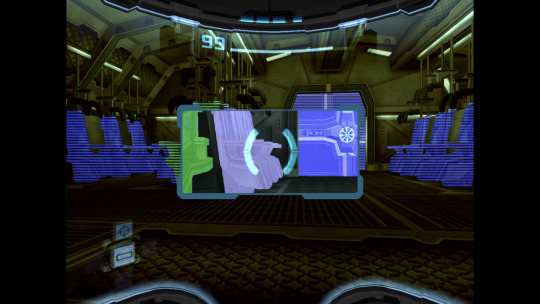
Yes, many of these chairs have to be scanned in small groups or individually for...some reason.
Metroid Prime 2: Echoes has all of the same problems as Metroid Prime and then really doubles down wasting the player’s time. The biggest change from Prime to Echoes is the introduction of the Dark World. The Dark World concept is pretty much lifted directly out of A Link to the Past, meaning that in order to make progress, you have to hop back and forth between the Light and Dark World in order to discover new areas, obtain new abilities, and change things in one world to impact the other. Conceptually, this is a great idea and it’s actually amazing it took until 2004 for this idea to be brought into the Metroid universe. Unfortunately, the execution is hampered by one extremely important detail: the Dark World actively hurts Samus just by being there.
I know there’s a story reason for all this, but it completely ruins the game. Initially, being in the Dark World at all takes a huge toll on your health very quickly, so you can’t spend very long in it. The only protection you get are these little beacons of light that project domes of safety. This, naturally, sets you up for the expectation that you’ll eventually get a suit upgrade that lets you withstand this constant HP drain. This is true, but it doesn’t happen until maybe the last (and most boring) 10% of the game that just has you backtracking through a bunch of areas to get some keys. Before that, you do get one suit upgrade that reduces the damage done, but you still take damage in the Dark World for the vast majority of the game, making exploring far more dangerous than it’s generally worth.
If you know what you’re doing, are good at the game, and don’t face too many issues with combat, you can get through the Dark World areas without losing too much health over time. Unfortunately, I’m not especially great at these games and tend to take a lot of punishment in enemy encounters. Since the game is extremely stingy with regard to its health and ammo pickups, I dread every time I have to go into the Dark World, fearful that I might get stuck out between safety zones or trapped fighting enemies for too long.
Thankfully, you can recover your health in the Dark World by hanging around those safety beacons. Unfortunately, the health restoration is so slow (about 1 HP every second), that you will spend a lot of time standing around doing nothing, waiting for your health to reach a point where you feel confident about going out and fighting or exploring more. I can’t think of a more blatant way to waste the player’s time. First, the suit that reduces the HP penalty in the Dark World should just eliminate the effect altogether. There is no really good reason you couldn’t take damage early on in the Dark World, find the suit upgrade, and then be free to traverse without penalty. I’d prefer that the Dark World not damage you at all, but I get that there is a narrative purpose to this, initially.
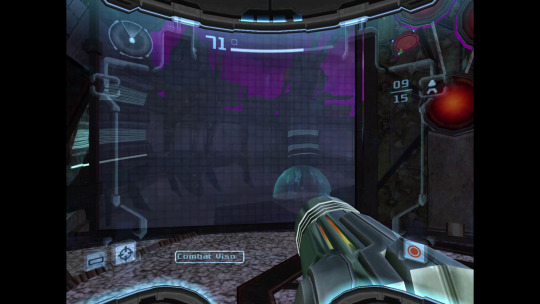
You’ll spend a lot of time just standing around in these safe pods, waiting.
What I can’t reconcile is just how slowly your HP regenerates when you’re in a safe zone. The reason it’s so slow is because there are enemies that engage you in rooms that contain these beacons and obviously they didn’t want players to be able to camp out under the beacon and just mindlessly shoot until the enemies died while they faced no serious danger. It seems that a better solution would have been to simply reduce the number of safety beacons a bit, or make sure enemy encounters were in areas that didn’t contain them. That way the threat of exploring would still exist, but if you did get in trouble, you could just backtrack to a beacon, stand around for a few second, then go back out and try again.
Instead, you still have to stand around beacons if you go exploring for too long or take too many hits, and the time spent doing it is drastically extended. Maybe having faster health regeneration would still make the game too easy, but I’d take a game that’s too easy over one that literally stops my progress so I can stand around for an arbitrarily long amount of time, actively making me not want to continue exploring.
Going back to the issue with detail, Prime 2’s map system does little to alleviate the inherent issues with exploring complicated level designs from the first-person perspective. One of the reasons I tend to have gripes with first-person perspective games is because they do a very poor job of mimicking what it’s like to actually see a space with your eyes. Most of this is related to peripheral vision what you can see in your peripheral vision in real life, as well as the fact that you can move your eyes around in your head, shifting your focus, without actually turning your head. You really can’t do that in games because you’re detached from the space by a screen. To look around, you have to physically move your character’s head (the camera) in the direction you want to look. It’s extremely disorienting to me and as a result I often get lost in games, even ones that don’t have levels as intricate as those found in the Prime series.
Naturally, there is a map in the game, and it is absolutely vital to navigating the game. However, reading the map is, in itself, a challenge because it, too, is in 3D. Honestly, it pretty much had to be. The levels in Echoes are extremely complicated (needlessly so, I’d say). Of course, it’s the same map that was used in the original Prime, but due to the levels not being as distinct in Echoes as they were in the first game, as well as the fact that you have a complementary map of the same areas to accommodate the Dark World, we’re looking at another area where you end up spending a great deal of time. I can’t tell you how many times I’d walk into a room, even one I’d been before, check the map, go into an adjacent room, then immediately go back to check the map. When you combine the time spent sitting around waiting to regain health and the time spent simply trying to orient yourself in the map (and often fighting with it since you can easily highlight rooms in floors above or below you by accident), it’s easy to see why the game can take around 20 hours to beat, even when really the game should take about half as long.
As I get older, I get a lot more irritated with games that do things simply to waste your time and pad out the play time. You really get the feeling that the changes made to Prime 2 were done specifically to make sure players spent more time with it, even if the quality of that time was drastically diminished compared to the first game. As such, Echoes is a vastly inferior game to its predecessor, and one that isn’t really worth revisiting. And if all the time wasting isn’t bad enough, it also introduced Dark Samus, which I consider the worst thing to ever happen to the Metroid franchise.
5 notes
·
View notes
Text
The Animations in Demon’s Souls Are Ridiculous
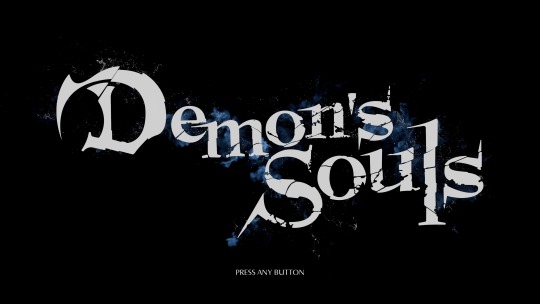

youtube

youtube


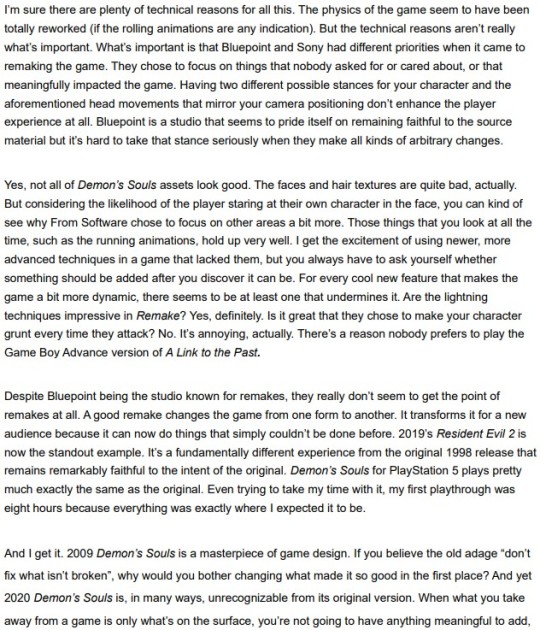


1 note
·
View note
Text
Nitpickery: QTE Button Prompts
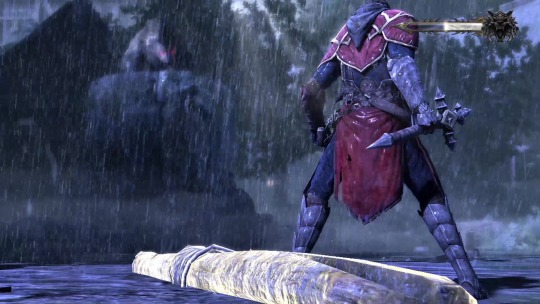
Castlevania: Lords of Shadow is far from perfect. Even so, it’s a game that I’ve played and replayed many times for the reason that it’s a satisfying combat action title. Its flaws tend to be the mildly irritating kind, and thus can be ignored easily enough, especially on multiple playthroughs. There is one aspect of the game, however, which does significantly impact my enjoyment of the game, and that is how it uses button prompts for the quick time events.
For the record, I don’t think quick time events are a particularly egregious offense. When you’re going for a particularly cinematic sequence that would otherwise be impossible given the camera’s normal operation, or if you build in quirky gimmicks into the combat, they can be engaging. No matter you implement them, the trick to pulling them off successfully rests in the consistency of their presentation. Lords of Shadow, unfortunately, completely misses the mark on this front in two very specific ways.
The first issue and biggest issue is the element of randomness to the button prompts. I’ll use the large lycan enemies for my example because I think they demonstrate this most clearly. When you hit a lycan enough times to stun them, they glow gold, letting you know that you can grab them to finish them off. There are two quick time events that you must complete in order to finish them off cleanly. First, you have to press any button once a larger circle shrinks down inside a smaller circle. I never really minded these because it doesn’t matter what button you push, so long as you push something with the correct number of frames. The second part is that you have to mash a particular face button once Gabriel Belmont places his foot on the lycan’s face. The button you need to mash simply depends upon which one the game wants to present to you for that particular sequence.

Circle, this time.
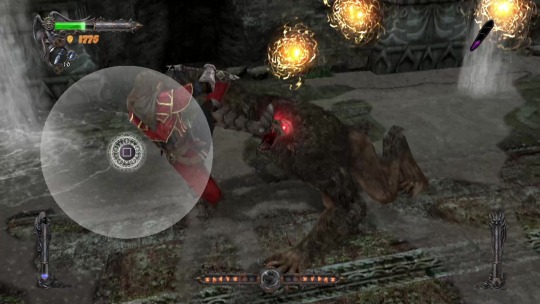
Square, this time, in the same fight.
There is only one reason to use different button prompts to perform the same action, and that is to punish players for not paying close enough attention. This should never be the goal of an action game that explicitly tells you what buttons to press and when. The controller, in the case of Lords of Shadow, is the apparatus through which the player controls Gabriel Belmont. It is essentially an analog for Gabriel’s body. In order for it to work that way, there have to be certain rules to its use. Pressing a button or combination of buttons has to perform a specific action and do so consistently so that the player can understand what they do and control the character successfully. If we go back to Gabriel’s foot on the lycan’s face, no matter how many lycans you grab and do this to, it is inherently the same action. Why, then, do I sometimes have to press A or Cross to do this, and sometimes Y or Circle? You have to do it that way because the developers decided the QTEs should be more like obstacles than methods to directly control Gabriel, sending mixed signals to the player about what the controller’s role in the game actually is.
While it might seem like a minor annoyance to some, I actually think using QTEs in this way subtly undermines the faith that players put in the game overall. I found myself regularly pressing the wrong buttons during normal combat, jumping when I meant to slash, or grabbing when I meant to block, because I was constantly being told by the random button prompts that there was no correlation between the buttons I was pressing and the action I was performing. Lords of Shadow is not the only game that takes this approach, though. You see it in Bayonetta as well, and it’s no less hostile to players there, either.
Bayonetta does have one major leg up on Lords of Shadow’s implementation, though, and that is in the graphical representation of the prompt. Bayonetta presents the buttons within the context of the controller itself. Rather than just an isolated graphic of the button that Lords of Shadow provides, you get a circle with the buttons that you need to press in the positions they would be on your controller. This is a small detail but it helps immensely. At that point, I don’t really even have to recognize the buttons, themselves, rather just the placement. Given that you likely aren’t looking at your controller very often while playing, its small touches like this that can alleviate a problem. Lords of Shadow does go halfway here, and puts the button prompt in a place on the screen that mimics where it would be on the controller, but the button graphic is in complete isolation. Without the controller context, it doesn’t do near enough to help the player identify the button quickly.
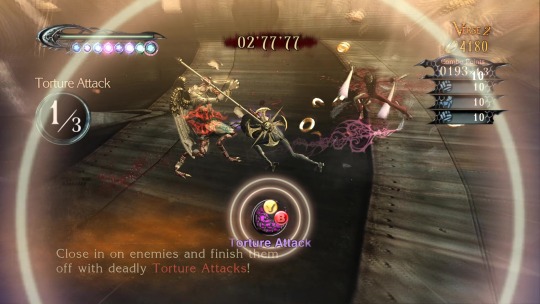
I’ll also mention that this problem is more pronounced for me on the Xbox 360 and PC version of Lords of Shadow. When Playing on the PlayStation 3, I found myself confusing buttons less often. I’m not sure if that’s because I just play more games on Sony consoles or what. I thought it might be due to Microsoft and Sega using one letter configuration and Nintendo using another, but I play plenty of Japanese games on PlayStation platforms that swap the confirm and cancel commands between the Cross and Circle buttons. Maybe I’m just illiterate.
Whether or not this kind of issue is a nitpick or not really depends on the person. For me, I think it definitely ventures into fundamental problem territory due to the erosion of trust between the game and the player. However, that very well may be an issue with me and not a more widespread problem. Of course, how you feel about it also probably largely has to do with how you feel about QTEs more generally. I’ve long felt that the line between QTE and just reacting to what’s happening in the game is very thin. Games like Demon’s Souls proved that enemies didn’t even have to flash a certain color or do anything outside their standard animations to clue players in to what they were about to do and how to react.
Meanwhile, Arkham Asylum used specific button prompts and consistent indicators above enemies to let you know when to block and dodge attacks or perform specific moves. Even From Software themselves, danced dangerously close to QTE territory with its warning messages that flash on screen in Sekiro, which surprised me considering how they had relied solely on animations to telegraph enemy behavior in most of their games. But then I remembered From Software also made Ninja Blade, maybe the QTEist game of them all, so I imagine they’ll stick around in some capacity for quite a while yet. If they do, hopefully they learn from the games that did them poorly so that they can at least not hinder the player’s progress for no good reason.
3 notes
·
View notes
Text
Great Adaptations: Why Ghost in the Shell Doesn’t Have One
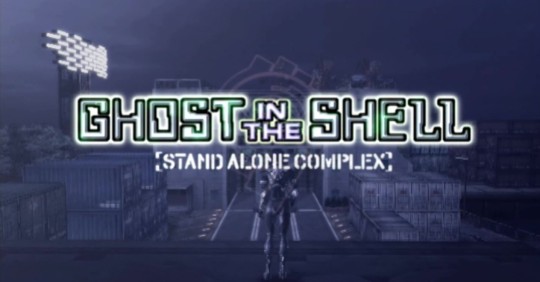
Before I say anything else, the things I say about Ghost in the Shell here assume a little bit of knowledge about the franchise. While I would have loved to have gone in depth on some of the things I mention, I don’t see a way to do that right now without, essentially, spending several years doing so. I’ve wanted to write about this topic, in some form or other, for a long time, and this is finally something I’ve been able to put down without getting lost in a fog.
It’s taken me a long time to write about Ghost in the Shell. Mostly, it’s because I didn’t know where to begin or which specific angle to write from. We’re talking about a multimedia property that began as a manga series in 1991 that grew to see tons of subsequent material in the form of more manga, animated films, and video games that continue to be put out to this day. The video game aspect was what had always been on my mind, but the question that has been bothering me all this time really only became clear recently. Why isn’t there a great Ghost in the Shell game?
Okay, that’s a bit of a loaded question. There are, actually, a couple pretty good Ghost in the Shell games. One of those is for the Sony PlayStation, which takes the form of an action shooter where the player acts as the pilot (or is it driver) of a Fuchikoma. Aesthetically, it absolutely nails the feeling of its parent franchise. The second is also an action shooter for the PlayStation 2, which does let the player control the series’ protagonist, Major Motoko Kusanagi, as well as a handful of other members of her team. They aren’t spectacular games, but they do have some solid mechanics, and in the case of Stand Alone Complex for the PS2, there’s a wholly original story to delve into accompanied by some solid animation from Production I.G, the studio responsible for every animated adaptation of the series. The real issues I take with all the games is that they don’t truly capture the spirit of Ghost in the Shell.

This brings me to the point where I have to grapple with just how big a beast the franchise really is. My feeling about the lack of a great game representing the spirit of Masamune Shirow’s work is because when I think of Ghost in the Shell, I’m very specifically thinking about the 1995 animated film. It turns out that the1995 film is actually something of an outlier for the franchise. Written by Kazunori Itō and directed by Mamoru Oshii, the film is something of an amalgamation of a few different story lines taken from the manga source material. Despite something of a cobbled together story, the film managed to do something that the manga never really did: give the main character a convincing internal motivation before the story’s climax.
I recall Ghost in the Shell being sold as an action-packed, violent, “adult” story. The truth of the matter is the film is not really an action film at all. There are exactly three action set-pieces over the course of the hour and twenty-three minute run time. Those action sequences don’t really play out much like action sequences, either. They don’t feature bombastic or heroic music. Kusanagi is literally invisible or, at best, translucent while she fights. For the time she is visible in a combat situation, she hides herself behind the cover, waiting until a safe opening before donning her invisibility cloak again. We know so little about the adversaries in these scenarios that there’s no feeling of triumph upon the Major’s victories. It’s almost an anti-action movie. That seems to fly in the face of a lot of the other Ghost in the Shell material, if not most of it.
To me, this is why no existing Ghost in the Shell game is really great. Action games need to have action in them, legitimately. But by conforming to the standards of action titles, the core identity of Ghost in the Shell is completely lost. There’s just no room to explore the conflict that Kusanagi feels about being compelled to work for an organization that has given her the cybernetic body she enjoys and requires to live her life. There’s no clear-cut way to frame what violence takes place without taking control the player’s control away.
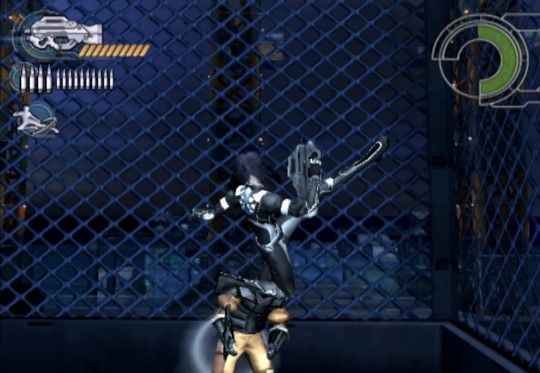
I might be in the minority in how I view the series, preferring the more “realistic” representation of the world and its inhabitants that the film took on. I am perplexed and intrigued by a Motoko Kusanagi that decides to merge with an AI as a result of her own existential crisis rather than being compelled to do so to avoid being prosecuted as a killer after being caught in the act.
Maybe most fans would be perfectly happy with something like a Metal Gear Solid game, just set in the Ghost in the Shell universe (hell, at this point I’d take that myself). Also, maybe most fans take no issue at all with an out and out action game. The Stand Alone Complex series seems to be the pinnacle for many fans out there, and it focused much more on the action, the technobabble that sounds more interesting than it really is, and of course, making Kusanagi look as sexually appealing as possible.
There are just so many of those kinds of games already, and almost none that explore the things that the 1995 film does because they aren’t the same kind of story. If a great Ghost in the Shell story is not, at its heart, an action story, then a great Ghost in the Shell game also couldn’t be an action game. Unfortunately, I don’t know what kind of game it would be. I’m not sure that there is such a thing as an anti-action game, but I do hope one day we find out.
0 notes
Text
Vampire Hunter D’s Lone Video Game Adaptation
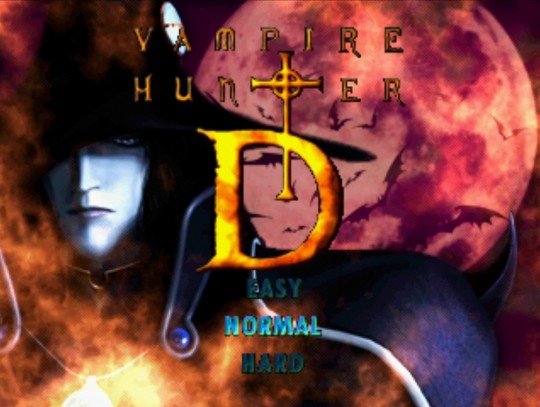
When people talk about PlayStation era 3D games being hard to go back to, Vampire Hunter D is the one I most often think about. Something of an alternate timeline version of the Vampire Hunter D: Bloodlust animated film, the game has you play as the vampire hunter, himself. Throughout the adventure, you explore the castle Chaythe to rescue a woman, Charlotte, from having been kidnapped by the vampire lord, Meier Link. I say it’s an alternate history because while the general plotting of the film (itself an adaptation of the third novel in Hideyuki Kikuchi’s series), the events of the game take place entirely within Chaythe, whereas only the last act of the film is set there.
The decision to condense the story to all take place within the castle is a brilliant move and makes for an interesting and thematically consistent setting. You work your way from room to room, finding items and solving puzzles to open up more of the castle to explore. All the while you must slay or evade enemies that stand in your path and battle the occasional boss. If any of this sounds familiar, it should. It’s the formula for the classic survival series, Resident Evil.
Vampire Hunter D does its best to disguise itself as a survival horror game. It has pretty much all the staples. There’s the spooky mansion setting, the keys and puzzles, the backtracking through areas to open previously inaccessible locations. There are pre-rendered backgrounds and static camera angles. Last and for many, definitely least, there are tank controls.
My feeling is that tank controls are perfectly fine for survival horror games where the player has no control over the camera. It makes sense that your directional movement would be absolute rather than depend upon the view of whatever area you happen to be in. The drawback, of course, is that precision movement is difficult and you often move a bit slower because it takes time for your character to turn to face whatever direction you want to go.
Vampire Hunter D is not a survival horror game. It’s an action adventure game. It’s an action adventure game with platforming, fast paced melee combat, and plenty of ways to keep yourself fighting fit in the form of consumable items. None of these things are made easier by way of tank controls and they are, by far, the biggest barrier to entry for players who might have otherwise really taken to the game. All it takes is getting stuck against a wall while being wailed on by an enemy or missing a jump due to a poor camera angle to sour the overall experience.
The game seems to be aware of just how inappropriate tank controls were as well, as other aspects of the game seem to exist purely to compensate for the movement. The platforming I mentioned earlier rarely has you leaping over dangerous gaps. Even the instances that do only set you back a few seconds or reset the current room with no penalty to your health points. Really, most of the time you just need to hop onto a box or a knee high ledge, which kind of makes you wonder why they bothered including it.
Tank controls really have their limitations in the combat. To compensate, by default, you lock onto the nearest enemy when you draw your sword. This alters your movement a bit as pressing left or right will have you circle around your target in that direction rather than having you turn your body to face that direction. This works fairly well in rooms that provide good visibility and aren’t too cramped, but can be pretty useless in tight hallways or if you're trying to work around more than one enemy at a time. Again, the developers at Victor Entertainment Software seem to have been aware of these limitations and generally limit the places where you face multiple enemies to specific sections of the game, many of which you can just run past if you need to. It’s no surprise that the bosses are all fought in more open rooms where you have ample room to run around, side step, and circle around while locked on.
It’s a shame that tank controls were what we were given. I understand why it was designed the way it was, but if any game could have been improved by having more standard 3D movement enabled, it would be this one. Perhaps most amusing is that there is analog support, but like Resident Evil, all it really does is map the tank controls to the analog stick rather than give you true freedom of movement we’ve become accustomed to over time. I have plenty of complaints about the movement in Devil May Cry, but something like that would have been a huge improvement over what ended up in the game.
While the movement controls may be frustrating during combat, the mechanics around combat are actually where Vampire Hunter D shines the most and why I think it’s a game worth exploring despite its shortcomings. Being half vampire, D’s prowess depends upon having a steady supply of blood. That vampire power is represented by the VP bar under your HP.. Overtime, your VP depletes and causes your attack power to drop and your magical abilities to weaken. You can recover VP in two ways: consume blood capsules that you find throughout the castle or be splashed with the blood of enemies you strike with your sword.
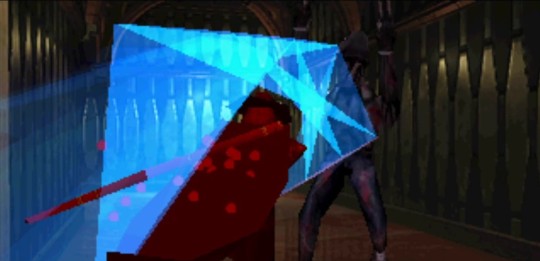
I love this idea because it provides incentive to engage in combat when you would otherwise be tempted to just run past as many enemies as possible. If you avoid fighting, you have to consume blood capsules. While they aren’t exactly in short supply on the normal difficulty, they are best served for boss fights or other tough enemies so that you can recover some health and your VP and deal as much damage as possible.
It’s not as balanced as it really should be, unfortunately. Your VP drains at a pretty slow rate, but it’s also hard to get back up to a high level through the blood splashes alone. It would have been interesting to have the meter drain more quickly, but also refill more quickly, adding a bit of urgency to the game and really encouraging you to take down any monsters you come across.
A similar mechanic is used for D’s magic abilities, which are made possible thanks to the parasite that lives within his left hand. There is an option to heal, an attack based magic that surrounds enemies and drains them of health, and the ability to absorb the souls of enemies. That soul absorption replenishes your magic meter, so while you want to refill your VP with sword strikes, you also want to make sure you inhale as many enemies into Left Hand as possible as well.
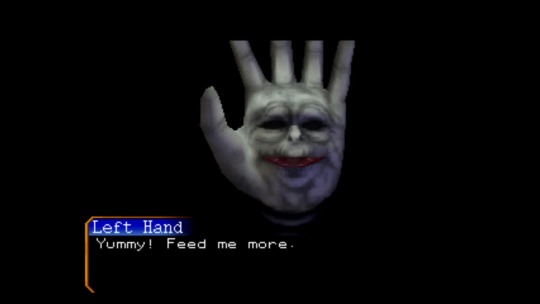
Again, this is a mechanic designed specifically to encourage killing the monsters in the castle and it’s a perfectly reasonable goal for an action game. Unfortunately, it has a bit of an opposite effect as absorbing enemies is not a guarantee and you’re likely to take damage when attempting it since you need to be in close proximity for it to work. If you try it and you can’t absorb one, you’ll almost certainly take a hit that would have otherwise been avoidable. It’s a shame the VP and magic replenishing systems weren’t all that complementary as the intent behind them really has a lot of merit and offers a glimpse at what could have been complex and satisfying combat mechanics.
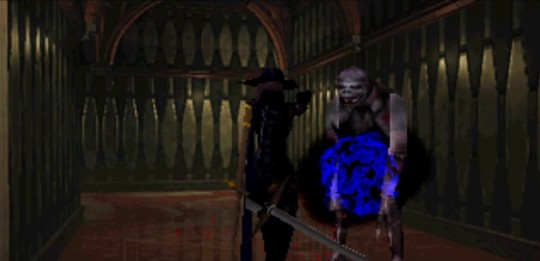
If you know what you’re doing, Vampire Hunter D is a fairly short game with a fair bit of replay value, as there are three endings you can achieve depending on a handful of choices you can make. I find the story to be one of the more compelling things about the game. It’s told through standard in-engine cutscenes and they’re acted fairly well (several of the actors from Bloodlust reprise their roles). Your enjoyment of that probably largely depends on whether or not you’re already a fan of the Vampire Hunter D source material or your feelings on sci-fi action horror in general, but there’s a lot to like about it.
I feel a bit bad for those who just aren’t able to enjoy older games due to feeling archaic. I can’t really defend the issues Vampire Hunter D has, as there are legitimate limitations and design choices that make the game frustrating at times. However, I also don’t want it to be dismissed as an old game not worth playing. You can tell just how much the people who made it really seemed to care about making it true to the Vampire Hunter D series. It’s about as faithful a video game adaptation as could be and one well worth spending some time with.
2 notes
·
View notes
Text
Why I Hope The Future of Castlevania (if There is One) Remembers Lords of Shadow

Some time ago I wrote about the two DLC chapters for Castlevania: Lords of Shadow and why you probably don’t want to play them. Those chapters are extremely disappointing and not representative of the game as a whole. As such, I always meant to write about the main game, but found it difficult to focus on something specific. Straight out reviews can be fun, but this is a big budget popular game we’re talking about. There are tons of reviews out there for it already. Instead, I want to talk about why the first installment of the series is still monumentally important to the franchise as a whole and why there are more lessons to learn from it for any future installments than there are to be learned from any other game in the series.
For any who don’t know, Lords of Shadow acts as a complete series reset. Several little elements from the original canon, if you can call it that, make their way into the game, though often in very different form. As I don’t get hung up about continuity or canon, this was an obvious good choice. It allowed MercurySteam and the folks at Konami to incorporate the things they liked about Castlevania without having the constraints of finding space within a pre-existing history. And like so many reboots, the story they chose was an origin story, both of the Belmonts and the series constant antagonist, Dracula.
Essentially, Lords of Shadow chronicles the birth of Dracula by way of the game protagonist, Gabriel Belmont. Unable to overcome the grief from the death of his wife, Marie, whom he killed while under the influence of belated antagonist, Zobek, Gabriel acquires incredible power and defeats Satan. Even after declaring to believe in forgiveness and receiving the forgiveness he so desperately seeks from his wife, Gabriel still descends into despair. We learn at the very end of the game that he’s forsaken humanity and become Dracula.
As the Lords of Shadow series broke away from the previous Castlevania timeline, so should a new 3D Castlevania game break away from the Lords of Shadow timeline. The poor reception to Lords of Shadow 2 killed that series and there is no point trying to bring it back. I’m certainly not eager to see a new origin story, but there’s no reason to think a new game would need to start at the beginning. Just as the original NES Castlevania started centuries after the first Belmont took up arms against the vampire lord, so too could a new title start at any point along a new timeline.
As large a departure from the source material as Lords of Shadow’s story was, the way it plays departed even further. Granted, none of the 3D entries truly capture the spirit of the 2D entries simply due to the nature of moving in 3D space. Castlevania and Legacy of Darkness for the Nintendo 64 adhered the closest, while Lament of Innocence and Curse of Darkness for the PlayStation 2 ventured more into brawler territory.
Lords of Shadow is heavy on the platforming, but rather than trying to time a perfect leap over a pit and Medusa head, you instead shimmy across ledges and use your whip to swing across gaps and repel down walls. It’s much more akin to how platforming works in a game like Prince of Persia: The Sands of Time or the rebooted Tomb Raider series. This allowed the game to showcase its art direction very specifically. Since the game controls the camera at all times, they could position you exactly how they wanted to give you pause at majestic waterfalls in the background, or exaggerate the sense of scale against towering bosses.

While I prefer camera control to rest with the player, there is something to be said for the framing that a game controlled camera allows for.
While I love the more ridiculous and difficult platforming of the Nintendo 64 games, there is a steep learning curve to it. On top of that, the hallmark problems of 3D platforming (issues with camera position and depth of field) have never really been solved. The negative impact of the symptoms may have been lessened over the years, but the core issues remain. That means you have essentially have to choose where to focus your game. Do you put your effort into making your platforming as excellent as challenging as rewarding as possible, or do you focus on the action elements?
Lords of Shadow focused largely on the action. The game is most satisfying when you have small groups of weaker enemies to tear through with your favorite combat techniques, or more difficult single enemies where you have to learn their patterns so you can time your dodges and blocks effectively. The only real complaint about the combat system is that many of the techniques that you can learn feel frivolous. Upgrading a handful of the basic ones is more than enough to get you through and it’s quite difficult to remember the numerous button combinations needed for each new technique you learn. It’s easy enough to use two or three that you know well and ignore everything else.
The more interesting aspect of combat are the various relic powers. These add holy or demonic magic properties to your techniques depending on which type of magic you have activated. I prefer these types of upgrades because they don’t require you to memorize a new set of commands for a marginal benefit. They simply amplify the effectiveness of certain techniques, and push you toward using certain ones. Having more of these that you could select from would have been a nice way to round out the combat without further complicating it. This is something I’d prefer to be lifted from the game rather than the basic combat elements. After all, there are other action games like Devil May Cry or Bayonetta that serve as better combat templates than Lords of Shadow.
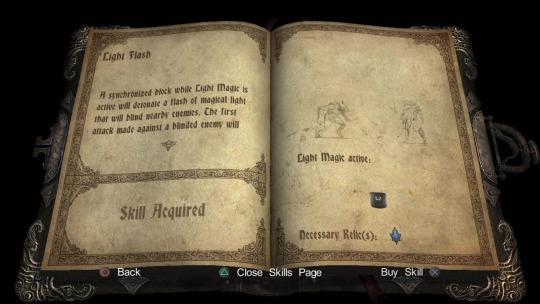
The outstanding question you may be asking is “why make a 3D Castlevania game at all?”. It’s a fair question. The games from the series that have really stood the test of time are those in 2D. The legacy of the classic NES titles and the Igavania titles is well-respected and lives on through an abundance of games that took inspiration for a reason. Igarashi himself managed to put together a spiritual successor to both Symphony of the Night and Dracula’s Curse, cementing that legacy for a long time to come. There is no such legacy for the 3D entries.
As much as I adore the quirks and charm of the 3D entries in the series, I’d be lying to myself if I said any of them were truly outstanding. Lords of Shadow may have come close, but its shortcomings are too numerous and the legacy of the series as a whole tarnishes even the brightest elements. Castlevania deserves a truly outstanding 3D game. The opportunity for it is there, so long as whoever makes it learns the lessons of how and why games like Lords of Shadow fall just short.
18 notes
·
View notes
Text
The Castlevania: Lords of Shadow DLC That Probably Shouldn’t Be

Despite owning the Castlevania: Lords of Shadow Collection, I never bothered to actually download and play the packed in DLC my first time around with the game. Since I wanted to talk about Lords of Shadow more generally, I figured my second playthrough would be as good an excuse as any to finally get through those last two chapters, Reverie and Resurrection. Before I get to that, however, I should say that Lords of Shadow is a game I enjoy immensely. It has a lot of problems that I can’t wait to delve deeper into, but I can’t help but have a great time while playing it. My second time through was even more enjoyable than the first. When you have a good grasp on the combat and know the solutions to puzzles ahead of time, the pace of the game feels more like it was intended. The cinematic approach the game strives so hard to achieve comes through quite effectively.
It’s safe to say, then, that I was really excited about the DLC chapters. Gabriel’s story arc over the course of the main game feels complete, but the reveal in the final cutscene that he’s become Dracula and he’s been hiding away in his castle until modern-day leaves ample room to explore what happened in between. Interestingly, MercurySteam initially had no plans to create DLC, according to the executive producer, Dave Cox. Rather, it was Konami, realizing they had a big hit on their hands, who wanted to capitalize on that popularity by throwing in some additional content. In hindsight, this really shows.
The biggest let down is in the character arcs, which is something the main game also struggled with. There is a huge disconnect between what the game tells the player they should be feeling through its use of heavy-handed journal entry reads and cutscenes, and what the player is doing moment to moment in the game. Gabriel is supposed to be losing his grip on his humanity thanks to his thirst for vengeance, but that struggle never shows up in what the player does. The abstract puzzle solving is enjoyable, but there’s no deeper meaning behind the gimmicks of the puzzles themselves. Meanwhile, the combat pits Gabriel against hordes of monsters that are inherently hostile. Whether Gabriel was actively seeking to fight them or not, there’s no question that Gabriel would be in danger if he ever happened across them. So all the time spent slaying those monsters can feel as much like self-preservation as it does Gabriel succumbing to his urges for violence.
To begin Reverie, Laura, the adopted vampire daughter of Carmilla, telepathically reaches out to Gabriel. She is desperate for his help and explains that an ancient evil, the Forgotten One, had been imprisoned by the founding members of the Brotherhood of Light. When they ascended, their Lords of Shadow counterparts maintained this prison. With the Lords of Shadow destroyed at Gabriel’s hand, the seal to the prison has grown weak and the Forgotten One’s escape is imminent. Gabriel, in his dejected state, refuses to help, at first, but a little cajoling from Laura convinces him.
Using a new, improved big bad as the reason for Gabriel and Laura’s paths to cross again feels contrived. Unfortunately there just isn’t any other way around that. However, the decision to use Laura in the DLC is a great choice. She resides in the castle that will eventually belong to Dracula, she has an established emotional connection to Gabriel, and her vampiric state is absolutely critical to the plot.
Reverie plays out much like any other chapter from the game, with Gabriel and Laura traversing the castle, fighting monsters, and solving puzzles to retrieve vials of blood from each of the Lords of Shadow, which act as keys to the Forgotten One’s prison. The added gimmick here is that the player takes control of Laura for some of these sections. Her vampiric powers of turning into mist allow her to pass through gated doorways that Gabriel can’t get through and replenish her health by consuming the blood of enemies. I commend the developers for trying to vary up the gameplay with the DLC, but being able to actually control Laura ends up detracting far more from the experience than it adds. Laura's ability to go through areas that Gabriel can't is only used a couple times, and instead of using that ability to navigate around and solve environmental puzzles, Laura just fights some zombies with some very poor combat mechanics.

Laura’s vampire abilities are terribly under-utilized.
This could have worked out a lot better with more appropriate level and puzzle designs, but I think it was a mistake to ever take the control away from Gabriel in the first place. The game is viewed through his lens, after all. He even narrates the prologues to the DLC chapters. I can't help but wish MercurySteam had taken some direct cues from ICO, where you could ask Laura to perform certain tasks or influence her behavior, but not control her directly. Of course, given the time and budget constraints MercurySteam was working under, it would have been an impossible task.
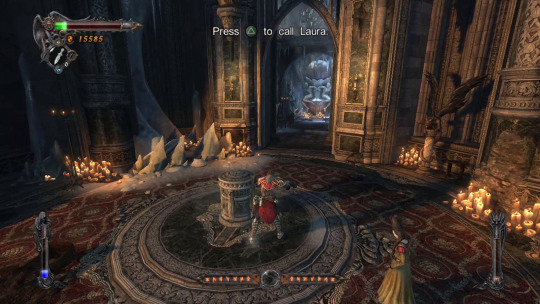
With all three containers of the blood of the Lords of Shadow retrieved, the seal to the Forgotten One's prison is opened. Unfortunately, Laura gives Gabriel the bad news that he won’t be able to enter the prison while he’s still alive as only dark beings can exist there. It's not explained why, but it serves to force Gabriel into making a decision. He can become undead by drinking Laura’s blood, or he can retain his humanity until the Forgotten One escapes and lays waste to the Earth. This decision is supposed to be made more difficult since Gabriel must consume all of Laura’s blood in order to turn, which will kill her.
This is where the lack of time given to this whole arc causes major issues with its emotional weight. Chapter XIII is about as long as every other chapter in the game, taking about an hour or so to complete. In that time we are expected to recall Gabriel's previous interactions with Laura, get to know her better, grow to like and empathize with her, and ultimately feel sorrow at having to end her undeath. The regret that Laura expresses only comes up in the cutscene where Gabriel is transformed. Before that, her dialogue portrays a confident and sarcastic character who seems in no hurry at all to die. Likewise, we are supposed to believe that it is in large part because Gabriel wants to end Laura’s suffering that he’s willing to forsake his own humanity. But you can’t have one without the other, so it just never feels convincing.

Despite being lightly animated paintings, I do quite like the cutscenes of the DLC.
If all that happens in Reverie, what happens in Resurrection, you might be asking. Gabriel chases the Forgotten One through a tedious, difficult to navigate lava obstacle course, then fights him to the death. In all honesty, Resurrection is a complete mess. It's the most intricate and challenging platforming the player is asked to do over the entire game, yet it takes place in the least visually distinctive level. There are tricky platforms to jump back and forth across, where missing results in instant death. There are timed elements where you have to wall-climb out of sight or face an instant death at the hands of the Forgotten One. And there's a collapsing staircase segment where you have to time jumps perfectly or it's back into the lava bath with you for another instant death. This whole segment really highlights how painful it is to not have any control over the camera whatsoever.
Other than a challenge of memorization and a bit of finger dexterity, nothing is accomplished at all with this chapter. We don't learn anything about the Forgotten One that we didn't already know in Chapter XIII, so I was absolutely shocked when he spoke before the boss fight. I figured it would act as some kind of primal beast, instinctual, and inherently non-human. Laura refers to him as a creature, after all. Nope, he's just a tough-talking baddie who wants to escape and destroy everything as revenge for being put in prison in the first place. For all his trouble of becoming a vampire, Gabriel doesn’t even get any new abilities. From the perspective of playing the game, there is no consequence whatsoever.
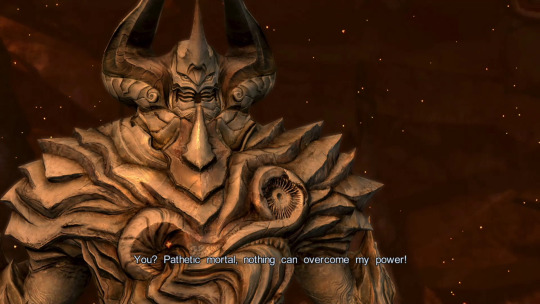
It seems like the Forgotten One forgot how not to talk in terrible clichés.
It's a real shame that MercurySteam chose to use one of its two DLC chapters on an obstacle course, especially when this whole ordeal is absolutely critical to Gabriel's character development. His decision to give in to darkness and become a vampire sets up the entire Castlevania franchise (or it was supposed to with the rebooted continuity), and ultimately, it just feels like a footnote. It’s, even more a shame that the publisher pressure and lack of execution on the DLC was a sign of things to come for the Lords of Shadow series.
0 notes
Text
The Dismemberment of Horror in Dead Space

After playing Dead Space for the first time I became increasingly frustrated by its attempts to be a horror game despite firmly planting its flag in the action camp. Action-horror is a tightrope walk between genres that I think rarely pans out, but that combination is alluring enough that I can’t fault anyone for trying. To me, action and horror are almost antithetical. Good action games provide a vehicle for players to feel powerful once they understand the mechanics and master them. Good horror games never let the player feel at ease, using the player’s expectations against them to keep them constantly unsettled.
Dead Space betrays its horror elements almost immediately. In two very important ways. First, the game’s monsters, the necromorphs, are revealed in all their gross glory before you even get two rooms deep into the mining ship you’re investigating, the Ishimura. You get onboard after crash landing in the opening cutscene, you walk into a room that’s got blood all over the floor, and then the necromorphs try to murder the entire crew you came with while you look on behind the complete safety of glass.
Dead Space takes so much inspiration from the 1979 film Alien as if the necromorphs weren’t a huge giveaway. But Alien works as a horror film because it spends the majority of its time building tension, first through the interpersonal issues of the crew, and then by having characters picked off one at a time by a monster the audience doesn’t really get to see. During that first encounter with the necromorphs you get a very clear look at them. You get an even better look when you’re chased into an elevator by one whose predatory instincts are questionable, at best.
Once you’ve seen the necromorphs, you know what you’re up against. This leads to the second way in which the game betrays horror, it tells you exactly how to deal with the necromorphs, and it does so in the absolute clumsiest way possible. Necromorphs need to have their appendages cut off in order to get them to cease reanimating and you get four opportunities in a row to learn this, two of which are impossible to skip. First, you find a message written in blood next to a body that says “Cut off their limbs”. Pretty straightforward. Minutes later, you can find an audio log where a crewmember says the same thing. Technically, both the bloody message and audio log can be skipped over or missed, but their placement makes that unlikely, at least on a first playthrough. What’s not skippable is the captain chiming in over your communication device saying the same thing as the audio log, followed by instructions from your suit that appear on the screen.
That’s four instances of the player receiving the same information all within the span of a couple minutes. I understand that severing necromorph limbs is the crux of the game’s entire combat, but when you tell the player the solution to fighting every single enemy in a game that’s supposed to scare them, you are doing them a terrible disservice. What makes this especially painful is that the player is given a subtle hint about cutting limbs off with the first necromorph that the player sees. As Isaac stands in the elevator while he’s being attacked, the elevator doors close and chop off the necromorph’s arm and head.
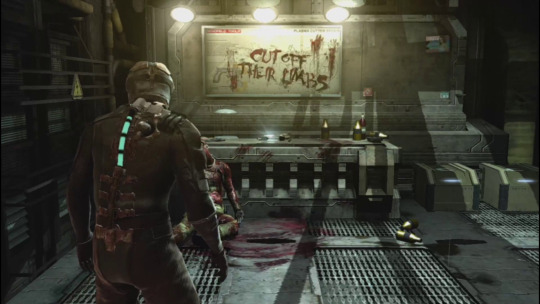
I am empathetic to developers not wanting players to get thrown into combat situations and repeatedly die because they don’t know what they should be doing, but this a game whose combat is modeled almost entirely on Resident Evil 4. In Resident Evil 4 you can shoot zombies in the legs to slow them down, you can shoot off their heads for quick kills, and you can even shoot thrown projectiles out of the air. None of this is told to the player, but it doesn’t take much experimentation to start figuring it out, which is arguably the most enjoyable part of the game. Dead Space never lets the player work out strategies for themselves, which can reduce the enjoyment and prevent the sensation of panic that horror games can elicit so well.
For all the things that Dead Space did well with regard to immersion, a few choices really break the illusion for me. There are a lot of small, but obvious issues. Necromorphs drop ammo and health items despite being horrifically twisted re-animated flesh with no need for either of these things. The ship is littered with caches of those same items, either built into the Ishimura’s structure or littered about the floor. There are also shops that allow you to buy health and ammo, as well as upgrade your protective suit.
All of these little problems add up to one big problem. All of the tools you end up using in the game only work in the context of a shooter. Sure, they try to justify the various weapons you can carry by giving them a tenuous relationship to mining, but even that is shaky. You first pick up the plasma cutter, presumably the most advanced type of mining tool in existence. So what purpose, then, does a circular saw serve? The answer is that the various tools flesh out the combat mechanics because they’re weapons, and nothing more. It would have been nice if the various tools could have been used to solve environmental puzzles and really explore the idea that Isaac is an engineer and not a soldier. Sadly, there’s nothing that Isaac ever does over the course of the game that doesn’t seem like something any other character couldn’t have done. The very existence of the item shops and upgrade stations pretty much proves it.
That brings me to the characters. This is where Dead Space felt the weakest to me. Every single character is a very broadly drawn archetype. You have a no-nonsense soldier, a nagging second-guesser, a mad scientist, a religious fanatic (well, several of them, actually), and the secret agent. To top it all off, you have the silent protagonist. Non-speaking player characters make a lot of sense in a lot of games, but it just doesn’t work out as well in Dead Space because your character has a personal reason for being on this particular mission: your girlfriend is on the Ishimura.
The first thing you see in the game is a video clip of Isaac’s beloved, Nicole Brennan. Kendra asks him about it, and the motivation is set. Isaac’s goal is to save Nicole. During the course of the game you do eventually run into her, and yet despite the horror show that both she and Isaac have gone through, Isaac does absolutely nothing even remotely resembling how one would react upon reuniting with a loved one. At the end of the game, we are treated to yet another obvious trope: Nicole’s been dead the whole time. I’m not sure if this was intended to actually be a plot twist or not, because it’s heavily foreshadowed. The video clip at the beginning clearly cuts off before it’s finished, and Isaac is arbitrarily kept from being close to her due to door locks that couldn’t possibly be activated if it wasn’t all occurring in his mind. When you finally are in the same room with her, Isaac has no reaction whatsoever. He’s supposed to be in love, but there is nothing even close to resembling human emotion coming from him.
One interesting explanation could have been that the trauma of the events has left him emotionally comatose, but instead, it’s all hand-waved away by the Marker. The Marker is a weird space object that is responsible for the necromorphs and drives anyone who spends enough time around it insane. Isaac is supposed to be a victim of this, and Kendra straight up tells us this after she reveals herself to the double-crosser that she is. It’s here that we get to see the video of Nicole played back in its entirety, and watch as she takes her own life to spare herself the horror of the situation.

The root of every element of the game can be clearly seen. You get your doses of Resident Evil 4, Alien, System Shock, and Event Horizon. Obviously, there are few or no true new ideas when it comes to stories, but what you want is a game that works to defy expectations a bit, and that allows the interactive elements to tell the story in ways other media can't. Dead Space doesn’t do this, it simply adds everything it can into one pot and hopes for the best.
For all its lack of a true sense of horror, Dead Space is still an immensely enjoyable action game, which is, itself, a huge accomplishment. You can try it for the first time a decade after its release like I did, and it plays just as well now as I’m sure it did then.
4 notes
·
View notes
Text
Great Adaptation Expectations - Sword of the Berserk: Guts' Rage
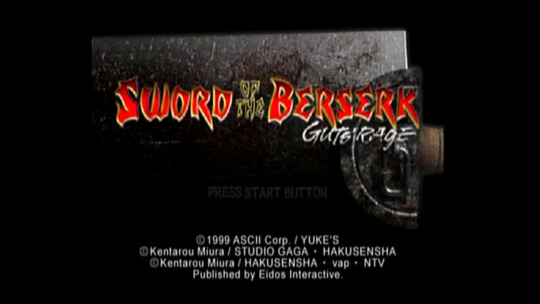
Some things just demand to be adapted into video games, and Kentaro Miura’s dark fantasy manga series Berserk stands pretty much atop that list. Released in 1999 and developed by Yuke’s in cooperation with Miura, Sword of the Berserk: Guts’ Rage is a third-person action game for the Sega Dreamcast that attempted to scratch that initial gamification itch, and ride the success following the first anime adaptation of the series, which premiered two years prior.
Before discussing the details, it’s important to note that Sword of the Berserk suffers the same fate that so many licensed games do. It isn’t very good. Some of that comes down to the era in which it was made. There are a few frustrations that plague it that are typical of an era in which 3D action games were relatively new. That isn’t to say there aren’t things to enjoy about the game. If nothing else, it did help solidify why the approach to how action games played needed to be adjusted. Unfortunately, that means Sword of the Berserk itself, is something of a missed opportunity. On the plus side, it’s not a very long game, so its shortcomings don’t have enough time to grossly overstay their welcome, and any suffering along the way is mercifully brief.
The first obvious issue is the lack of camera control. Going back to play any 3rd person action game without a controllable camera can feel extremely limiting. It’s become such a staple that it feels more unnatural not to have it than it probably did to have it when it was first introduced. Of course, there are certainly examples of very good games that lack it. You can’t control the camera in Onimusha or Devil May Cry, but you don’t tend to notice that limitation as much since the camera is placed in thought ways that reveal the relevant visual information to the player.
Sword of the Berserk’s camera lacks that thoughtfulness. It tries to be dynamic, moving along with your character, but the concern seems to be more on framing Guts in a particular way rather than assisting the player. Given that this is an adaptation of a beautifully drawn manga series, it’s hard to fault the developers for trying to capture some of that magic in their game (which they largely accomplish in the cutscenes), however, it ends up compromising its playability to a fairly extreme degree at times.
You also have the issue of moving toward the camera a lot, meaning you’ll often find yourself running headfirst into danger you can’t see until it’s too late. There’s even an escape sequence near the end of the game reminiscent of Sonic Adventure 2’s opening sequence. You have to run around and jump over obstacles with little warning before you’re right up against them. Without rings to help you cling to life, this is extremely frustrating. One mistake means you die, and in a game with limited checkpoints and continues, it can quickly become the hardest and most frustrating part of the entire experience.
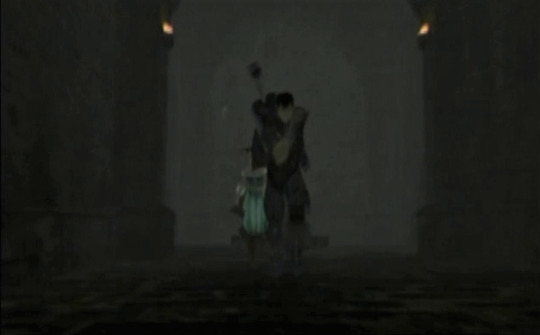
Rollin' around at the speed of sound/Got places to go, gotta follow my rainbow/Can't stick around, have to keep movin' on/Guess what lies ahead, only one way to find out!
Another part of what makes the camera so difficult is that it doesn’t have a lot of room to maneuver, even if the developers might have wanted to. You spend most of your time inside a castle, fighting through narrow corridors and cramped courtyards. In those confined spaces, the camera can’t really move wherever it wants because chances are, level geometry would get in the way. There are few examples of where this does actually happen, such as when you travel below the castle’s cemetery, and an obelisk sitting in the middle of the room complete obscures any figures that move behind it.
Aside from restricting the camera, the level design has the consequence of hampering what the game’s mechanics are centered around entirely, the combat. The whole point of a Berserk game is to play as Guts and swing the laughably huge Dragon Slayer sword around. There are several levels in this game where that is literally impossible. One level in particular, where you run through the castle town has several passageways where you’ll clank your sword against stone trying to land a hit on guards that hinder your progress. The developers seemed to realize this would be a problem, so they put in the option to sheath the Dragon Slayer and fight with your fists. I can say that this is not the most adequate solution. Even playing on the easy difficulty, punching guards out is a dubious proposition. Your damage output is drastically reduced and since the guards can snipe you with arrows from some distance with crossbows, you may well die before even getting the chance.

Let me just, uh, erm, hmm.
On some level, you have to respect the commitment to realism, as you obviously could not swing a sword the size of the Dragon Slayer in most places that human being typically occupy. However, the ability to swing said hunk of iron in the first place is fantastical, and thus, I think it would have been more than a fair compromise to let the sword simply clip through level geometry in an effort to make the combat more fluid and satisfying. Thankfully, the boss fights, which are the main draw of the game’s combat, are usually placed in much more open areas to avoid this issue.
Ultimately, I get the feeling that the game’s design took something of a back seat to the story that Kentaro Miura wanted to tell, and as such, there’s relatively little actual game to be played at all. Of the roughly four hours it takes to get through, most of that time is spent in cutscenes, making Sword of the Berserk more of an animated film than a game. Honestly, this does not really bother me. If you got the game because you were already a fan of Berserk, then what you’re getting is Berserk. What’s especially great about it is that the story told is unique to the game. It’s a side-quest, as it were, to the Millennium Falcon arc, where Guts has decided to keep the traumatized Casca close to him as he continues his quest to defeat Griffith. In this side story, Guts meets some traveling performers and decides to go watch their performance in a nearby town. He ends up walking into the middle of a conflict between the regions lord and people afflicted with a curse, called the Mandragora.
What’s more, is that the story is told quite well. For its time, the Dreamcast was a very capable platform for 3D graphics. Even twenty years later, the cutscenes are enjoyable to watch on their own if you’re willing to overlook a few flaws. Sure, the characters models are a bit blocky and they move a bit like action figures, but robotic movement is a problem that still plagues 3D animation if the 2016 Berserk or 2019 Ultraman anime is anything to go by. There’s still incredible attention to detail. The faces, in particular, have a lot of expression to them and help bring moments to life in a way that seems hard to believe at times.

You can really see the despair on his face.
It helps, too, that the voice acting is of very high quality. With well-known talents like Cam Clarke and Earl Boen, there was a clear emphasis on treating the game’s story seriously. This is extremely important since the story makes up pretty much the whole reason you’d be playing this game in the first place. There are some issues with the localization here and there (the name Guts is treated as a nickname rather than a given name in a few scenes), but the line delivery and interaction between characters really sell the scenes, even if the lines themselves are a bit clunky or cliched. When you compare the cutscenes in Sword of the Berserk to those in say, Tenchu: Stealth Assassins, released just a year earlier, you can’t help but appreciate the skill in direction and experience of the actors when stellar voice-acting in games was not a given.
You could argue that this story could have been served better through manga or traditional animation, but it’s hard to fault Yuke’s for wanting to make a Berserk game, or Miura for wanting to branch out and test the waters on new methods of conveying his story. Berserk’s popularity in Japan meant that a game based on the series was going to be made at some point, and creating a self-contained side story that can be begun and ended within that game makes perfect sense. It also helps make the game approachable by those who aren’t familiar with the series at all. In 1999, Berserk certainly wasn’t considered such a pinnacle of dark fantasy in the West as it is today, so someone picking the game off the shelf in the US would very likely have no frame of reference for the story at all. Thanks to the introduction of new characters like Rita, the player can learn what they need to know through the lens of those characters, making the reliance on that prior knowledge a lot less necessary.
Now that Berserk’s influence has become so far reaching, it seems unlikely that anyone would come to the Dreamcast game without some working knowledge of the series. While it’s hard to consider it a can’t miss part of the Berserk experience (save for the wonderful musical contributions of Susumu Hirasawa), there’s enough there for anyone willing to put up with some clunky design. At the very least, it’s worth watching a playthrough online for the story alone if the act of playing the game itself doesn’t manage to replicate the feeling of becoming the Black Swordsman himself.
4 notes
·
View notes
Text
Wrong Place, Wrong Time: Fatal Frame’s Maiden of Black Water
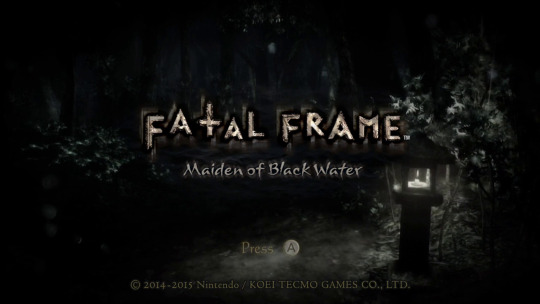
When the Wii U was announced and I saw early footage of the gamepad, which includes its own touchscreen designed for asymmetrical gaming, the very first thing I thought of was how perfect it would be for Fatal Frame. Tecmo’s partnering with Nintendo beginning back with Tsukihami no Kamen for the Wii was a clear statement that bridging the gap between player and game by way of hardware peripherals was the future for the series. Tecmo mostly delivered on that goal when it came to the Wii. While not a perfect game, Tsukihami no Kamen is one of the best entries in the series. It used a more unique setting, incorporated motion controls in relatively intuitive and meaningful ways, and even managed to enhance the audio presentation thanks to Nintendo’s quirky hardware designs. While it remains the most obscure title outside of Japan thanks to its lack of localization for other markets, it was both a great experiment and a great game.
With the Wii U gamepad, Fatal Frame: Maiden of Black Water could go one step further and put the Camera Obscura directly in the player’s hands. Series director, Makoto Shibata, indicated that he worked very closely with Nintendo regarding building the game around the Wii U’s unique capabilities. For the most part, the gamepad integration is exactly what you’d expect. When taking pictures, the player aims the gamepad in the direction of what they want to capture, using the screen as the viewfinder. The ZR button behaves like the typical shutter button present in the PS2 games. Physically moving the gamepad to navigate the world while the Camera Obscura allows for 360-degree tracking, which reduces the virtual layers between player and game while adding a physical layer that previous entries simply had no way to include.
With new possibilities come new challenges. Players have to balance looking at the gamepad and looking back up at the TV screen in order to get a good sense of where they are in relation to everything else. It is here, looking back and forth between two screens, that Maiden of Black Water builds the majority of its suspense. The confining nature of the viewfinder mode in the Fatal Frame series was always designed to make moments more dreadful. Going from the relative safety of the third person view to the first person perspective of the Camera Obscura, means you have to drastically reduce your visibility in order to accomplish goals within the games. When ghosts routinely try to ambush you from behind, being able to only look directly in front of you radically reduces your ability to defend yourself. In Maiden of Black Water, the risk that players must partake in to progress is taken to the extreme.
On one hand, being able to quickly peek at your television without having to change perspectives in the game’s UI makes for a better time. If you think you might be backing yourself into a corner, you can quickly focus on your TV to get a better view of your surroundings and make quick and informed adjustments. In the earlier series entries, you’d have to put the camera away, figure out what angle you were looking at the room from, then adjust from there. It worked beautifully for a horror game, but it was slow and imprecise at times. The Wii U’s gamepad reduces the time spent switching back and forth between viewing methods and gives a great deal more control over the camera itself.
On the other hand, having to focus on two different screens in real life can be just as, if not more disorienting than doing it virtually. I found my eyes often failing to adjust quickly when darting back and forth, and moving the camera around with my hands instead of just with the analog stick meant losing track of what I was looking at due to the natural blurring effects that happen when moving your head quickly. These issues became less pronounced with practice (and heavy use of the lock on mechanic), but they aren’t something that every player is going to be able to contend with. Thankfully, there’s an alternative option for those who aren’t able to or simply don’t want to use the gamepad in this way, which puts the camera’s viewfinder up on your TV screen instead, like the rest of the series.
Given how much experience so many of us have with cameras (or at least smartphones with cameras built into them), one would think very little training would be needed to make sure players have the skills they need to navigate this game successfully. Tecmo must not have had faith in its audience because the introduction to the game is a plodding mess of a tutorial section. In Tecmo’s defense, using the gamepad is not much like using a real-world camera at all. The reason for that, and where Tecmo deserves 100% of the blame, is because of how they decided to change things up for the combat. The ideas behind it are mostly the same as those codified by earlier entries in the series. Taking pictures of ghosts while they are close to increases the damage your shots do. The time spent focused on an enemy builds up the spirit power of your camera, and waiting until a fatal frame opportunity before taking the shot will deal out the biggest hits and return the most points. Those things all work more or less as expected.
The big addition to the suite of combat mechanics, requiring multiple hovering targets to be captured in a single photo with the main spirit, is not an easy enough concept to leave up to players to figure out on their own. In Koei Tecmo’s effort to explain it in-game, since they couldn’t be bothered to create a manual, is to render the first enemies in the game almost completely harmless. The first enemies in these games have never been particularly threatening, but just how dangerous they are isn’t something the player is aware of unless they make a mistake. Even then, enough mistakes could kill the player outright and the encounter takes place at the same pace as every other encounter in the game.
In Maiden of Black Water, the first ghost you fight stands still for the majority of the experience as on-screen prompts walk you step by step through each facet of using the camera for combat. Only once does the ghost try to lunge for you, which is prefaced by text telling you it’s going to happen. The vast majority of ghost encounters are scripted, of course, but the lack of facade here betrays the uncertainty that is vital to establishing a horror atmosphere. There’s just no way to be afraid of an enemy’s attack if the game tells you it’s coming well beforehand and doesn’t bother to even make it punishing if you fail it. It’s not a bone-chilling start, despite how hard the cutscene directors try to make it seem otherwise.
Fatal Frame has always included plenty of in-game information on how its systems work and how to maximize damage in combat, but its tutorializing was never so exposed. In previous entries, some text pops up on screen as new mechanics are introduced. The player can either read it or hammer a button to skip right on through. After that, these documents are tucked away for later reference if needed and the player is left on their own to make good on whatever knowledge they’ve acquired. It would be a stretch to say Tecmo ever managed to pull off tutorialization with any real elegance, but the quick and dirty approach of simply putting pieces of the manual into the game worked well enough. They even have just enough of a narrative reason to exist, since they are often presented as notes left NPCs. It’s not a seamless integration, but it’s enough to keep the game’s facade acceptable, if not totally believable.
Having played the entire series again, one lesson learned is that complicating a horror game’s systems does not make it more frightening. The original Fatal Frame is maybe the scariest of the bunch, badly delivered dialogue and all. It pulled this off despite offering the lowest level of technical expertise because it focused on the world’s presentation over the method with which you dispatched spirits. While Fatal Frame is also arguably one of the easier games in the series, that lack of difficulty doesn’t come at the expense of its dreadful tone or the carefully crafted sequences that make it so haunting.
As the series progressed, it became more and more about making the combat interesting, adding features, drawing more and more attention to evaluating player performance, and letting the environmental storytelling take a back seat. Maiden of Black Water has the most involved combat system out of any of the games, and with the gamepad at the center of it all, the game’s world had to be built more around the limitations of players using it rather than the capabilities that such a device allowed for.
Those human limitations of understanding and reacting to the overcomplicated combat resulted in the game being compromised in ways that previous installments weren’t. The Wii U is the most powerful system that a Fatal Frame game has appeared on, yet its art direction just doesn’t convey an otherworldliness that makes ghosts unsettling. The lack of light in the early games, resulting in lots of negative space on the screen, is nonexistent in Maiden of Black Water. The warping effects around the spirits have almost been preserved, but they also give off a glow that makes them look like a soft, dim light bulb more so than a soul stretching across two planes of existence. They are weirdly opaque and easy to spot, which may have been a result of technical limitations on the count of the Wii U, but could also be a result of needing them to be more easily identifiable for the player’s benefit.
Ghosts often appear in groups of three or four, which means they need to have a minimum amount of space to move around and for the player to move around and between them. Because of the multi-target damage multiplying mechanic, players need even greater distance between themselves and their enemies in order to get clear shots of all of the targets at once. It’s surprisingly rare to be in a cramped location. The introductory sections are easily the most dangerous architecturally, even though there are no real threats there. In earlier games, it would be common to be ambushed by a ghost in a narrow corridor. Since it was impossible to keep a lock on a ghost that spent most of its time behind walls, this would force players to run to a larger connecting room where they could maintain eye contact with the spirit to build their spirit charge and deal decent damage.
So much of Maiden of Black Water takes place outdoors in a forest that has pretty good visibility. There are paths that limit your movement a little bit, but there is little in the way of obstructed views, so even if you can’t move around all that much, you can see far enough and the ghosts are distinguishable enough that you can still have a pretty fair fight no matter where you are. It’s only when fighting a big group at once or particular ghosts that can deal ongoing damage to you that things get really hard to manage. It’s always cumbersome no matter the difficulty, and the time it takes to learn the ins and outs of the mechanics, the various input sensitivity, and ghost AI tendencies leaves little time to realize that these are supposed to be harrowing situations.

There’s not a single location in any other Fatal Frame game as open as this.
This all makes for a challenging game, but not a scary one. Over time, I’ve definitely become desensitized to the tricks that Tecmo uses to elicit fear in players. I recognize the AI, I recognize the tells in the level design, and I understand the pacing well enough to predict when certain things are going to happen. Even knowing what I know about these games, I can still go back to most of them and get chills when a figure appears behind me in a mirror or when a ball suddenly starts bouncing towards me down the stairs. Maiden of Black Water actually has a few moments that used this knowledge against me. There are so many dolls strewn about the various locations that I was certain they would turn into a jump scare or become an enemy for me to take down on my way to complete some task. This doesn’t really happen, and that restraint shows that, on some level, this team still knows how to keep players on edge. It’s just a shame it that more often than not, the subtle horror that wore down a player’s defenses was traded for a more action-oriented style of play.
Had that same level of restraint been applied to more facets of the game, I think Maiden of Black Water could have been a classic horror game. It could have given all the people who scoffed at the Wii U gamepad’s gimmicks something to chew on. It could have shown why horror is the perfect genre for tech such as augmented reality and VR. Fewer, but denser locations, fewer but more meaningful ghost encounters, and a back to basics kind of combat would have allowed the truly innovative parts of the game to really shine. Turning the gamepad on its side to put the camera into portrait mode is brilliant. Being able to turn around in a complete circle and have the gamepad screen track correctly is inspired. These genuinely unique features are just buried under a bunch of superficial additions, getting in the way. With all those extra layers built on top of the foundation, there’s just no way for the horror to make its way to the surface.
The superficiality present in the series really comes to head for the sixth installment. Where we saw increasing sexualization of characters as the series progressed, Maiden of Black Water does just about everything it can to elicit arousal as much as fear. This is nothing new for the horror genre, but it is a sharp turn away from the more subtle elements of horror and toward blatant titillation. The female main characters are attractive young women who wear incredibly impractical clothing for the type of locations they explore (a short dress and short shorts aren’t exactly appropriate gear for traversing a rain-soaked mountain).
That same rain ties into a new mechanic where getting wet increases the amount of damage the player can deal while increasing the amount of damage they’ll suffer if hit. The longer the player is exposed to rain or wades through standing water, the wetter they get, and the more pronounced the water’s effects are. As the player gets waterlogged, their clothing also reacts, getting darker in color, and clinging to the characters. This would provide wonderfully non-intrusive visual feedback invaluable for players were it not for the meter that appears on screen which gives the player the exact same information.
From a game polish perspective, the clothes changing with the environments is a must. It would be very distracting to watch a player plunge waist deep into a creek only to have them walk out of it dry as a bone. It’s mechanical importance, which could have been essential, is instead aimed at making Ruka and Miu more and more physically appealing. The white garments become nearly transparent, revealing cleavage, and the clinging fabric tends to more readily define the most curvaceous aspects of their bodies. The concerted effort to make the game sexier reaches absurd heights with some of the costumes available as unlockables, which amount to little more than lingerie. These costumes were changed to costumes based on Nintendo characters for North America, which is a fun workaround, but hardly solves the increased sex appeal of the game. Samus Aran’s skin-tight Zero Suit is one costume, with Zelda’s dress from Twilight Princess being the other. Both of these costumes cover more skin, surely, but the amount of fanart dedicated to these particular Nintendo characters suggests that it would only add fuel to the fire.
Shibata revealed that the characters were intentionally more sexualized over the life of the series. Though he claims it was due to “his own fixation”, he does comment that it did fit within the overall style of Koei Tecmo’s games. This company cultural inclusion is really at the expense of the game, as it serves as a distraction from, rather than an addition to, the game’s overall thematic structure. There’s no game-specific purpose to making the characters sexier other than to appeal to players who like looking at attractive women. They don’t pursue sexual relationships with other characters or act on this sexualization in any way that would give justification to it. That lack of cohesion between elements reduces the impact of those elements. Their artificiality becomes harder to ignore, and it’s hard to be frightened when you don’t believe what you’re seeing.
Given the delayed digital-only release and the lack of exposure to a broad player base thanks to the lack of the success of the Wii U, one has to wonder if Koei Tecmo has any more Fatal Frame games in them. They have been produced with surprising regularity considering their relatively low profile, but it’s hard to see where else the series has to go. The Wii U, by all accounts, should have offered the best possible experience, yet it failed to capture the spirit of the early games that made them so great. While not as obviously camera like as the Wii U’s gamepad, Nintendo’s Switch, with its portable design, could just as easily house another game, and its much bigger install base would practically guarantee that a new game made it into more hands. As a fan of the series, even at its lowest points, I would always welcome another game. At this point, however, it seems a bit unlikely that we’ll see one.
It’s a bittersweet feeling to think you might have played the last game in a series you love, and it’s even harder when the game that ended it wasn’t one of your favorites, but Maiden of Black Water deserves a much better fate than it got. Even after all these years, the Fatal Frame franchise still stands pretty much alone in the horror genre. Few games are so evocative of true horror, and fewer still try to create new ways for players to immerse themselves by way of player input and manipulation. Sure, Maiden of Black Water ditches a lot of that for a more fast-paced, arcade-style experience, but it’s still a Fatal Frame, and it’s still more enjoyable than the majority of games of its budget and scale.
0 notes
Text
Middle Child Syndrome: Fatal Frame III

Fatal Frame III: The Tormented sits in a weird place among the entries in the classic horror series. After the novelty of the first game and the refinements of the second, The Tormented starts to retread some very familiar territory. There are more old, abandoned and haunted mansions, more hostile ghosts that need exorcizing, and the same Camera Obscura with which you take pictures to solve puzzles and rid said haunted mansions of the undead. The general idea of the game is identical to its predecessors. If you’ve played through the entire series, you know that there is a familiar sense of core elements and a consistent quality that invites comparisons to the NES line of Mega Man games. As such it’s easy to overlook the game as just another sequel that does more of the same. Done and done.
That would really be selling the game short, though. While not nearly as celebrated as Fatal Frame II: Crimson Butterfly, or as controversial a release as The Maiden of Black Water, The Tormented veers off the beaten path in surprising ways. Sure, you spend the majority of your time doing the exact same things you do in every Fatal Frame game, but the story has a more personal side to it. It also isn’t all haunted house all the time. There are things to do outside of playing paparazzi to the angry spirits of people who met untimely and gruesome ends. There are characters that you can interact with, and loads of quiet time.
I haven’t talked at great length about the story of the other Fatal Frame games for a couple of reasons. First, they are all set up as mysteries. Going into a lot of detail about them would diminish the rewarding sense of discovery you get when you uncover more journal entries or newspaper clippings that allow you to fit the timeline of the story’s events together. Second, the stories being told were never all that satisfying to me. Learning exactly how the ancient ritual that keeps the spirits of hell away got botched for the third or fourth time loses a bit of its luster. There’s nothing wrong with that framework, and you have to expect it to some degree with a series that is self-referential and takes place in some semblance of a timeline. Still, the possibilities to go beyond the failed ritual scenario have been surprisingly unexplored. Fatal Frame III makes a valiant attempt.
In The Tormented, you follow Rei Kurosawa in the aftermath of the loss of her fiance, Yuu Asou. Rei bears the responsibility of Yuu’s death, as she feels it was her inattentive driving that caused the accident he was killed in. Having survived the accident, Rei suffers from tremendous guilt. That is a heavy stage to set and contrasts wildly with the previous setups of “my brother is lost and I think he might be in this creepy mansion” as seen in the original game, and “we were running through the woods and now we’re in some creepy, abandoned village that appeared out of nowhere”. The themes in the series have always leaned very hard into dark and disturbing territory. Who could forget the slightly hinted at taboo relationship between twins Mio and Mayu from Crimson Butterfly, or the horrifically unethical medical experiments performed on mental patients in Mask of the Lunar Eclipse? Where the series had previously begun its games with big, open-ended mysteries, III was the first to begin its story with such a specific focus on the details that ground both the lead into the plot and the character whose the lens the player will be experiencing the plot through.
Rei’s grief and guilt are the emotional frameworks upon which The Tormented is built. That subtitle essentially gives the theme of the game (and the entire series, for that matter) away right off the bat. It’s one thing to have an interesting story framework, though. It’s another to elevate that story through the integration of its themes into something the player can take part in. To that end, Fatal Frame III is comprised of two distinct phases. There’s the dream phase, where Rei (and occasionally other characters) explores The Manor of Sleep and uncovers information about various ghosts she encounters while there. This is also where the player does all of their ghost hunting with the Camera Obscura.
There’s also the waking phase. This phase is set in Rei’s home, which she shares with Miku Hinasaki. Miku is the protagonist of the first Fatal Frame and she works for Rei as an assistant. While awake, the player can develop certain pictures taken while in the dream state in her home’s dark room. Those photos can then be given to Miku to investigate the characters or events revealed in the film. The other main component of waking up is simply to take a breather from the harrowing experiences of investigating the mansion while eluding the tattooed woman hell-bent on tracking Rei down. Having structured quiet time makes the difference between the emotional highs and lows of the game more pronounced and even. The house, taking the role of refuge, completely recontextualizes the nature of the mansion exploration as set forth in the previous entries in the series. Where before the game’s protagonists were forced deeper and deeper into exploration in an effort to find what they were looking for or free themselves, Rei gets to act more like a spelunker. She explores the same horrifying locations and situations as the characters in the other games, but she does so with a rope (somewhat) firmly tied back to reality.
The cyclical nature of sleeping and waking is then twisted over time. The safe haven of Rei’s home, which included having Rei’s health restored and her film replenished, begins to feel less safe over time, especially as night falls. Apparitions tucked away in corners can be seen flickering in and out of existence, the constant rainfall outside acts as somewhat of a psychological barrier to leaving the house. It’s as though Rei’s dreams are forcing their way into her consciousness slowly over the course of the game, which is a more oppressively sinister emotional path to walk for both Rei and the player. What was once a welcomed relief erodes into more uncertainty, cementing the effects of the trauma that Rei undergoes.
The subtlety of Rei’s descent into the trappings of guilt is propped up in some unexpected ways. There are the aforementioned hauntings in Rei’s home introduced over time, but there are more subtle touches that magnify the effects of her emotional deterioration. Elements as omnipresent as the UI seem oddly understated compared to the games it’s sandwiched between. Compare how busy the viewfinder is of a mildly upgraded camera is in Fatal Frame II and a similarly upgraded camera in III.

Fatal Frame II: Crimson Butterfly

Fatal Frame III: The Tormented
The highlighting around the reticle, which indicates the charge of your spirit power, is so subtle that upon picking this game back up again, I completely missed it for the better part of my first fight. I’m not exactly sure why the Camera Obscura has such a minimalist representation when the trend in the rest of the series was to amplify its feedback to 11. It’s not even like it fits in with the rest of the UI features, which saw more shortcut buttons and menu options than previously provided. It certainly seems that breaking immersion wasn’t particularly on the list of worries, so the only options left seem to be that the developers just wanted to give the player more screen real estate with which to frame the ghosts they would be taking pictures of, or they felt that toning down the flashing lights and alarm bells would keep the mood somber, preventing it from clashing horribly with the tone of the narrative. It could be both at the same time. Whether intentional or accidental, Tecmo completely nailed it.
Being the third installment of a series means there were plenty of opportunities to adjust and fine tune features that might have been underdeveloped in previous games. There is still some redundancy in how the player takes pictures, for example, being able to use either the R1 or X buttons, but that’s much better than the three possible buttons used in the previous title. A big improvement was getting rid of having two camera viewfinder control options active at the same time. Fatal Frame and Fatal Frame II allowed for movement of the Camera Obscura’s viewfinder with both the analog stick and directional pad, an odd choice considering the PlayStation 2 had integrated analog control built in from the beginning. The Tormented fixes that, leaving control simply with the left analog stick. By doing this, they freed up the D-pad to be used for swapping film types during combat without forcing the player into a series of menus, which would take them out of the action and ruin the pacing.
Fatal Frame III is full of these small improvements. The system menu options were moved from the Start button to Select, which allowed for the game menu options to be moved from Triangle to Start, which then allowed the Camera Obscura to be raised or lowered with Triangle instead of Circle, putting it much closer to R1, which is used as the shutter button. The map, a huge time saving and confusion busting tool, was moved to the L2 button, which went completely unused in previous entries. One of the best improvements involved implementing an older constraint from the first game that had been “corrected” for the sequel.
Film in Fatal Frame is finite. If the player does a poor job managing their film either in combat or when taking pictures of wandering ghosts or other things of interest, they can either run out completely (admittedly difficult to do as there is more than enough scattered around the mansion), or more worryingly, run low or out of the most rare and powerful film types because their damage capacities weren’t maximized. The team at Tecmo realized that there was a real possibility that players could put themselves into an unwinnable situation, and to make sure that couldn’t happen in the sequel, they introduced a type of film that was infinite. Its capture power was very weak to compensate for having an unending supply, but it was a nice safeguard against both running out of film completely and also against being forced to use more powerful film when it wasn’t really necessary.
Fatal Frame III rides the line between these two extremes. All film types have a limited supply, like in the original game. Two of those types, Type-7 and Type-14, refill to a set amount when Rei wakes up from her dream hours. This accomplishes the goal of heightening the tension of each dream by forcing players to be conscious of how much film they’re using and for what, and also provides an extra dose of relief once players reach the end of a dream segment. There’s an additional benefit to aiding players in mentally pacing the game, as they can form a pretty good idea of about how far into a segment they are based on how much film they’ve consumed, assuming they haven’t gone above and beyond in exploration and searched out every possible film drop possible. The mixing of old and new series ideas demonstrates the importance of looking at the games in a franchise holistically, as there can be great ideas tucked away in entries that can easily get overlooked in the rush to keep things fresh.
Unfortunately, refinements don’t really make for huge selling points, which may be part of the reason why the game is underrepresented when it comes to the series as a whole. It looks the best and typically plays the best of the PS2 games, but not because it made any huge design overhauls. It simply examined what it was that players most often spent their time doing in Fatal Frame and made those features more logical and accessible. It’s as if the Camera Obscura viewfinder’s visual design was a representation of the elegance that this game was going for.
For all that it gets right, Fatal Frame III does, of course, have flaws. Those flaws largely derive from the expectation that players of the game are familiar with the series. Aside from relying upon up the stories of previous games, it also borrows much of its level design from them as well. Revisiting levels familiar to seasoned veterans of a series can be a nice surprise. The Tormented takes this idea to its logical conclusion and basically creates a new game using the locations of the previous two games. The Manor of Sleep, for all intents and purposes, is a combination of Crimson Butterfly’s Lost Village, and Fatal Frame’s Himuro Mansion. There’s really nothing wrong with this in principle, but Tecmo’s reliance on familiar architecture allowed them to slip a little with regard to guiding the player along the right path. Far too often it feels as though players need to rely on past experiences with the games in order to figure out where to go because Fatal Frame III doesn’t really bother to give them adequate clues. This is an intermittent problem. The first quarter of the game is fine, and there’s even one section when controlling Miku where the player has to rely on audio cues to figure out where to go which works extremely well. There are other sections, however, such as Hour VI, where guidance is a little less straightforward. You don’t really take any pictures revealing other locations, there aren’t spirits walking about to point your way, you just have to wander around a bit until you stumble upon the place you’re supposed to be. It’s clunky and does a great disservice to the sections that are well planned out.
The difficulty of the game is another issue that normally wouldn’t be worth mentioning except that it’s tied to the lack of context clues seen in previous games. During Hour VII, Miku ventures into a crawl space beneath the house in order to reach a previously inaccessible area. This area of the map is set up beautifully by way of Rei commenting earlier in the game on her inability to pass through it if the player inspects the opening while in control of her. There’s also a later section where a ghost can be seen hanging out, her body contorted in an off-putting way. When it’s time for Miku to crawl through this space, the player is ready for something. With a set up that good, it’s a shame that the payoff is so weak. What the player finds is an incredibly difficult enemy to fight. While crawling, the game forces you into first-person mode, whether you have the camera raised or not. This limited view makes the ghost, who crawls around on all fours with the frantic pace of cockroach, very difficult to locate quickly. Her attacks are swift, as well. She approaches the player abruptly before pausing ever so slightly and ringing the neck of Miku.

Her spider-like ceiling walk is especially frightening.
It’s obvious there is something wrong with this encounter based on how little damage this ghost does to you upon each attack. If you fail to get a shutter chance on her (and you will), she hangs on to you for a long time. During that time, she drains a minuscule amount of life compared to even the weakest of enemies in other parts of the game. With such little health at risk, it suggests that players are not really meant to engage with this ghost at all, which makes one wonder why they bothered putting her in the game in the first place. After getting strangled weakly for the third or fourth time, I figured I’d just keep on crawling so I could get to my destination, which worked out perfectly. My constant movement made it so the ghost could no longer land hits on me, and she was unable to follow me out of the crawl space.
To say this whole section was a disappointment is an understatement. Because the situation is treacherous, it seems that Tecmo just couldn’t resist putting an enemy here, which would be fine if that enemy had animations that the player could deal with more comfortably. It doesn’t. To compensate for how difficult the timing is for landing shots in her, they simply made her incredibly weak, which takes away all tension from the situation. Players can fail time and time again on this fight without real risk of dying, so the overall scare factor drops to nothing. The animations no longer frighten once seen repeated fifty times. A better option would have probably been to have some clue that a ghost is nearby, but never actually reveal her. Having the player go into a confined space was already enough to ramp up the tension, so much so that actually executing on that tension made for the least scary scenario possible.
Another reason why this particular ghost encounter sticks out is that it occurs roughly halfway through the game. The halfway mark is where the game starts to falter a bit. Where it hits the pavement is in the sheer number of ghost hostile ghost encounters. There are tons. On top of the scripted fights, which must be completed to progress, ghosts can randomly pop up all over the place, even in areas once thought safe. There’s an element of surprise here that serves to undermine whatever sense of security a player might have developed when going through certain areas of the Manor of Sleep, but it becomes overkill almost immediately. Sometimes two ghosts can show up back to back, other times you might fight one, move on, then have the same ghost reappear during a backtrack to a different part of the mansion.
Having repeat ghosts already feels unsatisfying because it eliminates any sense of accomplishment the player had when taking them out the first time. The point of the Camera Obscura is to exorcize spirits, and if it isn’t actually accomplishing that, then the integrity of the narrative completely falls apart. The other major side effect of this is fatigue. The Fatal Frame games are not easy. Exploring takes time, the puzzles, though not mind melting, take a bit of thought or planning to complete. Throwing in fights every other room is daunting, reduces the impact of those encounters, and gives the player incentive to avoid them at all costs. This takes away opportunities to get points to level up the camera and additional abilities, crucial elements of the game that must be done in order to combat the spikes in difficulty. It’s a shame when games appear to actively discourage players from participating in the mechanics that make up the core of the experience, and The Tormented is quite guilty of this in several chapters.
The middle section of the game is also where the training wheels come off with regard to figuring out where to go, not something that makes a great deal of sense considering the amount of backtracking the players are required to put up with. Traveling back and forth between the same rooms dozens of times requires some guidance so that players don’t begin to wander about aimlessly. It’s inevitable that a player is going to run into some blocked doors or impassable spaces, but it doesn’t take hitting too many of these in a row before the adventure starts to fall flat and the feeling of frustration dominates the experience. As a general rule, leading the player on is something Fatal Frame III does really well. There’s a night where Miku’s destinations are signaled by the sound of singing. Locating the sound becomes the game, and it’s an interesting way to provide the player with the solution of where to go without simply jotting down the right room on the map. The uneven application of these unique guidance tricks makes the game feel longer than it is, and horror games are particularly damaged by wearing out their welcome.
Having a bit of a slump in the pacing is an issue, but can certainly be overlooked when viewing the game as a whole. What can’t be ignored is how Tecmo treats its main protagonist, Rei. It shouldn’t be a surprise that the developers responsible for the Dead or Alive series would have some issues regarding representations of women. Sadly, the Fatal Frame series is not free of this problem. With the protagonist of The Tormented being an adult woman, Tecmo was able to overtly sexualize her in a way that feels a lot more familiar to fans of Western horror movies (not to mention sexualization of the main antagonist, who goes bare-breasted throughout the game). Sure, you could read incestuous undertones into the relationship between twins Mayu and Mio from Fatal Frame II, but that served to make the characters more enigmatic and eerie, a reasonable thing to do for a horror game. The fanservice content that did exist was reserved for bonus content and was entirely optional. This is not so with Rei. Even jiggle physics make it into the game, if subtle. Rei’s breasts don’t heave or sway like Mai Shiranui when she runs or quick turns, but there is a distinct butt bounce that is noticeable when she runs. It can be hard to see as it requires the camera being placed close to Rei in an area where she would be moving away from the player’s view, but it’s definitely there, and it’s difficult to justify a reason for its existence. It ended up distracting me quite a lot once I’d noticed it. Maybe that doesn’t say something so flattering about me, but one has to wonder what the intent was with including it, as it seems animated too well to be accidental.
To further Re’s unfortunate portrayal, we get a scene of Rei taking a shower in a half-hearted attempt to convey her difficult time coping. It’s a bit difficult to empathize with her situation, though, when the scene is served with a very generous side of boob. It’s jarring because Rei is just an average woman who’s lost the person she loves most and feels immense guilt about it. She isn’t action star Aya Brea from Parasite Eve running around shooting mutated monsters with a shotgun. Trying to mix in a bit of sex appeal here just doesn’t sit well. The shower trope is repeated later on to more mixed results.

This scene is more Nightmare on Elm Street than Fatal Frame.
This mixed messaging doesn’t hurt the narrative to an irreparable degree, but it certainly does the game no favors, and when your main problem as a game is that you are easily overlooked, it’s this kind of objectification of its characters that makes passing the game by not feel like such a bad thing.
The biggest regret of the game is that its most dramatic moment, the showdown with the Tattooed Woman, has a fatal flaw. That flaw is an instant fail state. One hit deaths feel bad in pretty much every game, but for Fatal Frame, they are especially cheap. The series has these littered throughout, and normally they are easy enough to avoid. Maybe you get caught once, but after that, it’s a good lesson learned. Fatal Frame III decided it would make half of the final boss fight subject to them with a healthy dose of randomness to make the medicine go down. The fight begins normally, with the Tattooed Woman becoming hostile while also becoming vulnerable to your camera. Intermittently, however, she will transform the scene so that it takes on the black and white film grain look that’s been peppered throughout other Hours. During this time, the Woman appears in a random location and you must run from her until things go back to normal. The randomness of her appearance and her ceaseless pursuit of your character make avoiding her challenging, and sometimes, literally impossible. If you get touched, you die. Death at this stage is especially punishing because the player must quit out to the game’s main menu in order to reload their last save. If the last possible save point, the trek back to the boss room isn’t especially far, but it’s enough that the time going back for another try after a death caused without fault from the player really adds up. This is a horrible choice for any boss, let alone the final one.
For this fight alone, it’s hard to blame anyone who honestly hates this game. It’s so bad that it is hard to remember anything else about the game as you fight back the tears of frustration. Of the three games, The Tormented easily feels like the most difficult for me, and poor design decisions like this are a big reason why. It would be one thing if the difficulty had some semblance of fairness to it. Maybe the Tattooed Woman’s moveset could be especially varied or challenging. Maybe she would have a fairly simple moveset but hit very hard in order to punish impatient players with jumpy trigger fingers. Taking control away from players is great for instilling fear, but it’s equally good at instilling rage, which is really all this boss fight accomplishes. What’s amazing is that even upgrading my camera as much as possible and using Type Zero film exclusively, which is the most powerful in the game, I still died numerous times simply because I couldn’t turn around fast enough to avoid some grabby hands.
With all games, you have to weigh the good with the bad. Fatal Frame III’s lows are certainly low due to their feeling of cheapness with regard to eliciting thrills or titillation. Those lows, however, far from sink the game to the level that its reputation seems to have sunk it. Maybe the quick development of these games simply led to oversaturation. Half of the entire series was released in about a three year period, which is remarkable. With that, you’re going to see a lot of corners being cut. The Tormented lacked originality in its locations and ghosts, but it more than made up for those shortcomings through its unique use of those existing assets. From a lore perspective, it’s also crucial, as it expands on the original game’s story and incorporates elements from the second to create a cohesive fictional universe for the fans who really crave that kind of thing. Fatal Frame and Fatal Frame II are more complete games because they have the third game to connect all the dots, even if they didn’t really need to be connected in the first place.
The series would change drastically with its next iteration, moving away from the fixed camera, adopting a whole new control scheme, and abandoning the characters that had established it as one of the premier horror titles. Given that it never made it out of Japan, it’s hard to see those radical departures as being completely successful. The Tormented, then, sits in the kind of limbo that the player strives to make their way out of. It’s the point between staying true to what works and reinventing the wheel. What risks it took were overshadowed by where it played it safe, not unlike what happened to Capcom’s Resident Evil 3. There are far worse fates than good, if not spectacular. If you choose to play Fatal Frame III for yourself, you’ll come across plenty of them.
#fatal frame#fatal frame 2#fatal frame 3#project zero#mask of the lunar eclipse#koei tecmo#playstation 2
14 notes
·
View notes
Text
Project Zero 2: Wii Edition and the Remake Dilemma

I’m a firm believer that remakes are typically losing propositions. There are cases that buck this trend as there always are (Resident Evil comes to mind), but when it comes to games that can be considered landmark titles in their respective genres, or just superbly made games, the benefit of a remake is limited to its availability on new platforms. This is something a port could accomplish with significantly less risk of messing with the integrity and intent of the original creation. Sometimes, though, games are completely overhauled for one reason or another. Project Zero 2: Wii Edition falls into this category.
A remake of the 2003 PlayStation 2 and Xbox release, known in the US as Fatal Frame II: Crimson Butterfly, Project Zero 2: Wii Edition uses two basic templates from which it forms its mold. The first is the original game. Fatal Frame II was a pretty big step forward from its predecessor. It maintained the basic underpinnings of exploring haunted old buildings and fighting ghosts by taking pictures of them with a magic camera, but it added some significant and interesting changes. In Crimson Butterfly you don’t go through the whole house of horrors alone. Your twin sister often tags along as your AI companion. This means she can alert you to the location of ghosts, and can also become the target of their attacks. The mechanics of camera combat are tweaked as well, where your proximity to ghosts is used to scale your damage up more than the time multiplier used in the first game. Because of this, ghosts often have jittery animations that make getting close to them risky and capturing them with combo inducing fatal frames difficult. The explorable area is also expanded out to several sometimes connected buildings and the space between those buildings in a small village compared to the single mansion that made up the first game.
Wii Edition borrows Crimson Butterfly’s structural framework practically wholesale. The level design in almost unchanged, the combat parameters are pretty much the same, and your AI sister manages to get in your way just about as often. What’s different is everything else. Shedding the fixed camera angles so common in survival horror games, Project Zero 2 takes its presentation from its console release cousin, Zero: Tsukihami no Kamen. Released four years earlier in 2008, Tsukihami no Kamen completely shifted how the Fatal Frame games were presented to players and how players interacted with them. The camera went from fixed and set tracking to being pulled in over the player character’s shoulder. It became dynamic, the player could direct it with a certain amount of freedom to focus on what they wanted to in the environment. Motion control was also introduced to more accurately convey the feeling of aiming a flashlight and camera around. It was a complete break from what the series had been doing up until that point, and Project Zero 2: Wii Edition fully embraces these changes.
The mix of classic Fatal Frame level design with modern Fatal Frame camera angles and control schemes produces mixed results. For lack of a better term, the game is clumsy. This manifests itself in some interesting ways. First is the unoptimized menu navigation. As you explore the Lost Village, you come across a variety of objects that reveal lore. Most of these are paper documents of various types. Picking one up will open the article so you can read it. To close it, you first press B on the Wii remote to stop reading, then press A to close the text. This might not sound so bad, not adjusting the purpose of a single button to match player intent in context-sensitive ways makes quickly navigating the menu both confusing to learn and quite difficult to do quickly. While the backstory to the Fatal Frame games is interesting and worth taking the time to investigate, repeat playthroughs don’t always require that you read a seven-page journal entry again. The menu system actively works against playing quickly or efficiently. Considering how much time players have to spend in menus, missteps here can add up to some significant time loss.
Time lost to players doesn’t seem to have been a concern for Koei Tecmo when developing this game as it also features unskippable cutscenes. Wii Edition is not a game that is overwhelmed by its pre-rendered scenes, but they are frequent enough that they disrupt play in regular intervals. For first time players, they probably aren’t something you’d want to gloss over as they provide guidance on what to do next but they are far, far less important for those who have played the game before. Not being able to skip these scenes is especially odd considering the odds that many people playing the remake of Crimson Butterfly also played the original and are familiar with the story already. Forcing players to watch cutscenes always ends up feeling like the player is having control taken away from them, and it’s especially painful here due to the more general issues with player control.
Perhaps the easiest target with regard to player control is how it feels to move the player character around. Unfortunately, Mio and Mayu feel very slow. Slow movement on its own is not a problem, but the game does not feel balanced around the movement speed. A prime example is the sluggishness of the quick turn. What was a snappy animation that turned you around 180 degrees in Tsukihami no Kamen became a set piece of animation reorienting the character that feels as if it’s playing back in slow motion. The animation itself isn’t even particularly slow, but the built-in delay to the starting of that animation makes the whole thing feel unnaturally labored. It’s a much less useful technique because of this. Timing it right during combat becomes more a test of how well you anticipate a ghost’s actions rather than how quickly you can react, which is unfair to ask of players when ghosts spend so much of their time hidden from player view.
The slow movement might have been the result of the game taking place in such tight quarters, a problem created when spaces aren’t redesigned to match the other changes. The slow animations feel like a safeguard against players running themselves into walls constantly or rushing past something they were supposed to pay attention to. This is taken to an extreme in one particular room where the player can walk through a pair of hanging curtains. Going through them triggers an especially aggravating animation of Mio nervously pushing the curtain back before stepping forward. These animations are triggered by proximity to the curtain rather than the on-screen prompt to press A like in nearly every other interaction in the game. It’s a particularly bad moment. If you just to happen to be ambushed by a ghost while doing this, suddenly you can rush through the curtains at full running speed with no issue, demonstrating the arbitrary nature of Mio’s movement limitations. Unfortunately, the forced pace feels like it creates more problems than it solves. Players just have to suffer through everything taking a bit longer than it probably should, with backtracking or getting temporarily lost compounding the problem.

Getting ambushed here is about as dirty a trick as the game can play.
Combat also suffers some unexpected clunkiness. All Fatal Frame games are a bit clunky when it comes to wielding the Camera Obscura, though this has the express purpose of making the game both challenging and tapping into the fear of the player, who might perform the wrong action due to a panicked state. In Zero: Tsukihami no Kamen, the imprecise motion controls of the Wii were mitigated by the lock on mechanic. One could argue this made the game a bit too easy, but Project Zero 2 for Wii goes very far in the other direction. The lock on keeps your camera in the vicinity of your nearest target, and the player must adjust their aim within the lock by rolling the Wii remote to either side or pointing it up or down. Locking on happens quickly and is accompanied by a satisfying shink sound that provides the player with positive feedback. Hearing it, you get the sense that the hard part is over and now it’s just a matter of waiting for a fatal frame chance.
Really, your photo album efforts are just beginning as the ghosts can easily disappear out of your lock on, reducing your spirit energy levels back to nothing. What you’re supposed to do is lock on, then diligently follow along, making minute adjustments to the position of the Wii remote in order to keep the ghost centered in the viewfinder. This is no easy feat, especially if your Wii remote calibration is off or you have a less than ideal location for the sensor bar. The semi-automated lock on and precision aiming feel at odds with one another. Adding in the analog stick of the nunchuck on top of that for turning your character around and you have three methods of controlling the aim of the Camera Obscura, all of which just get in each other’s way. Its lack of complementary components is all the more surprising since it had worked so much better in the previous Wii effort. While Tsukihami no Kamen’s combat could certainly have used some fine tuning, Wii Edition reduced that complete package back down to its individual pieces without remembering how they were supposed to fit back together.
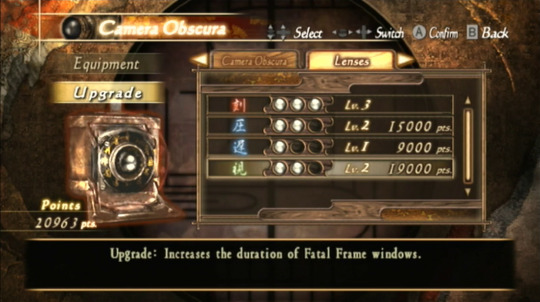
The game really forces you to upgrade as much as possible since your basic film does very little damage and getting fatal frame combos is quite difficult compared to the other games in the series.
A quirkier addition for combat scenarios is the blacking out of the screen during certain encounters. There you are, tracking a ghost as it glides around the room while you charge your spirit meter, when suddenly the room goes completely dark. You lose the ability of your filament to point you toward the ghost’s position right along with the ability to see anything. It’s supposed to add tension, maybe even give you a fright. The first time it happens, it gets close to accomplishing that. At the very least you’ll be surprised. That raising of the stakes fails to deliver once you figure out that the underhanded tactic of your spectral enemy goes away after a few seconds and in the meantime, you can just run around to avoid getting caught unaware. It’s a fun new trick to see once, but it doesn’t force the player to reassess their predicament or use new strategies to deal damage to ghosts. The same exact methods of evasion work just as well, you simply have to wait until the lights come back on to hurt your foe.
Since the game was released in PAL regions, it did receive localized voice acting in English. What might be a surprise to those of us in North America is that the dub was done with English voice actors, meaning it differs wildly from the original English language dub that was produced for North America and PAL regions. For those familiar with the original game, it’s quite off-putting to hear these new voices. For a game so rooted in being Japanese, non-Japanese voice acting always felt a little strange. To their credit, the actors who worked on Project Zero: Wii Edition did a fantastic job, and once you’ve become accustomed to it, I find that it often outshines the original English dub. Sadly, the English dub is the only one you can choose from despite its release in multiple European countries and featuring several language options for the subtitles and menus (I played the Italian release, complete with box art and manual, printed in Italian). The Japanese audio isn’t even available, which is a real shame, as it would have been nice to give the characters their presumed native language to give it that much more coherency. Of course, multi-language tracks were still uncommon in 2012, so you take what you can get.
Aside from getting an English dub, the greatest thing about the PAL release of Wii Edition is that it made the game available to a wider audience. If you only happen to have a North American Wii, however, you face the same kinds of problems trying to play this game as you do trying to play the fourth game. Without a PAL or Japanese console, you can’t simply pop a disc in and start playing. If you don’t want to invest in another console for a single game, then the easy answer is emulation. Wii emulation is in a very good state, so the game is easily playable on PC, though you are likely to get some audio stuttering and maybe a bit of slowdown. You can even get a USB sensor bar and pair your Wii remote with your computer to replicate the control scheme exactly. If you want to play on your North American console, you can also do that thanks to the robust homebrew community for the console. Bypassing the region lockout using sideloaded applications means you can play the game on actual hardware exactly as one would expect, and it works flawlessly. If you really want to, you can also track down an undubbed version of the game which features the original Japanese audio with the texts of the various PAL region languages.
With so many available options to play it, the question really becomes whether or not it’s worth playing. For anyone who loves Fatal Frame, the answer is easy enough. Yes. It’s interesting to see the game redesigned for a completely different perspective. It’s fun to hear the extremely different voice acting, and at its core, it’s very much the same type of game that all the games in the series are. You can’t really go wrong with it in that regard. For those who might be coming late to the series, I’d have to recommend the original over this version. Crimson Butterfly is readily available, can be played digitally in HD via the PlayStation 3, and simply holds up better as an overall package. If you love motion controls but only have room in your life for one Fatal Frame game to try, then you’re better off going with Zero: Tsukihami no Kamen. It’s more responsive animations, more appropriately designed locales, and tighter Camera Obscura mechanics make it the obvious choice. It also incorporates the Wii’s motion control gimmicks in interesting and surprising ways that truly enhance the experience, something Project Zero 2: Wii Edition curiously omits. For a remake, Wii Edition doesn’t make much of a case for itself being the definitive version. It acts more as a companion piece to the original, a super new game plus, almost. It’s one to come back to only once you’ve made your way through the rest of the series and still want more
3 notes
·
View notes
Text
24 Fatal Frames Per Second
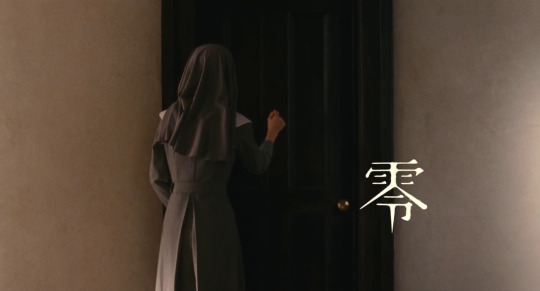
Few video game series are as tailor-made for film adaptations as Fatal Frame. The act of investigating a haunted location and dispelling spirits by taking pictures of them with a magical camera make for great game mechanics and are uniquely suited to work just as well (if a bit differently) in a non-interactive medium. This transitive property of the premise is largely thanks to Fatal Frame taking such heavy inspiration from film in the first place. The techniques pioneered by Japanese horror films, such as Ju-On and Ring, are liberally used throughout the Fatal Frame series to elicit the same levels of dread in the players that audiences of those films experienced. The innovation of Fatal Frame is really just that it transformed a passive media like film into an interactive game far more successfully than most game makers can hope for.
Given how close the relationship between Fatal Frame and horror films is, it surprised me to learn that it took all the way until 2014 for a film adaptation of the series to be made. It surprised me, even more, to learn that none of the storylines from the games were cribbed for the film’s plot. Instead, a light novel by author Eiji Ōtsuka, loosely based around the Fatal Frame concepts, was penned instead. On some level, this circuitous route to making a Fatal Frame film makes the most sense. The films that inspired Fatal Frame were themselves inspired and adapted from horror novels. Unfortunately for hardcore fans of the video games, the resulting film, Gekijōban Zero, borrows a lot more from other films in the genre than it does from the games.
Gekijōban Zero’s story revolves around the all-female students of a prestigious Catholic boarding school in an otherwise nondescript town. The students of the school are seemingly obsessed with two things, a particularly attractive student named Aya, and a curse said to only affect girls. Over the course of the film, Aya and another student, Michi, uncover the secret behind this curse. For the students of the boarding school, the curse refers to a kind of love spell girls cast over each other. To enact it, they kiss a picture of the girl they admire just before midnight, and this will cause the person in the picture to return their affection.
Already there is a great deal to unpack. The “curse that only affects girls”, which is repeated often throughout the movie, almost like an incantation, is an interesting phrase that specifically references the view held by many belief systems about menstruation. That the story takes place in a Catholic school adds an interesting element of conservativism that lends itself well to Western audiences, whether intended or not. Indeed, in Eiji Ōtsuka’s novel, menstruation is frequently mentioned with regard to one of the story’s main protagonists, Michi, and her preternatural ability to see ghosts. The inherent link between the supernatural and femaleness is significantly downplayed in the film compared to the novel, however. In the novel, Michi’s ability to see spirits is relegated to a single eye at a time. To account for this, she wears an eyepatch to prevent herself from detecting them. During her period, the ability shifts to her uncovered eye for reasons that aren’t really explained clearly, but make for interesting characterization. In the film, overt references to menstruation are significantly reduced, to the point where Michi does not wear an eyepatch, rendering that entire element of her character non-existent.
It is revealed over the course of the story that the curse is a mix of a few different things, beginning in the 19th century with suicide pacts performed between lesbian couples. Unable to live their lives freely, these couples would take pictures of themselves, kiss their lover’s photo, then place them side by side in a frame to be hung up in the town’s family owned photography studio. Once this was done, they would drown themselves in a nearby lake to ensure that their spirits would be joined together in the afterlife. These pacts were performed periodically over time, resulting in the spirits of many couples inhabiting the waters that made up the lake. By the time in which the film takes place, the lake had been drained and the water stored in a well hidden deep within the surrounding forest.
After Aya locks herself up in her room, several girls in the school yearn to see her, and unwittingly perform part of the suicide ritual by kissing Aya’s photo just before midnight. Doing so causes their disappearance, and eventually, their bodies are found floating in a river. Michi helps convince Aya to help her solve the mystery of the curse in order to prevent any other girls from falling victim to it, as well as to free those already cursed. The rest of the film plays out more or less as one would expect. A handful of tragic backstories are brought to light, and Aya learns the truth about the origin of the curse she was tasked with lifting.
While the story is satisfying enough, it leans very heavily on established tropes of earlier horror films. They can be difficult to overlook once recognized, to the point where they seem almost shoehorned in. Probably the most obvious example is Aya’s discovery of the body of her twin sister, Maya, in the water storage tank. Left alone in the tank to drown, Maya resurfaces to explain how the curse began and that she does not want Aya to share her fate. As the two reconcile, Maya’s spirit leaves and Aya is left embracing her corpse, which quickly falls apart and disappears back underwater. The similarities between this scene and the climax of 1998’s Ring are unmistakable.
Another trope taken right out of broader horror is the false resolution. With Maya discovered, Aya’s curse is lifted and the girls of Loudon academy are safe. The headmistress reveals that she is the one responsible for the curse for failing to kill herself along with her lover. That betrayal caused her to be haunted by her lover’s spirit. To satisfy the spirit, she sacrificed Maya so her lover would have a companion in the afterlife. That satisfying conclusion is undercut by the threat that the original curse still remains. As the new crop of students arrives, they quickly begin whispering to each other about a curse that only affects girls.
Despite borrowing the majority of its storytelling vocabulary from film, Gekijōban Zero does have some distinctly Fatal Frame touches that offer some exciting moments for fans of the series. The sacrificial ritual the headmistress performs to satisfy a spirit from the next plane of existence is very much rooted in the stories and lore of Fatal Frame. Every game centers around sacrificial rites going horribly awry or having unintended consequences, and the film adaptation is no different. While Maya’s sacrifice is a far cry from the brutal rites practiced in the game by some secluded group of people high in the mountains or on some tiny forgotten island, it is equally disturbing and has its roots in longstanding traditions just as is done in the games.
The Camera Obscura also makes an obligatory appearance. It’s not used to exorcize or fight ghosts, but it does still have the unique ability to capture them on film. Susumu, a boy whose family founded the town’s photography studio, carries it with him wherever he goes. It produced the photo of Aya that everyone used to become cursed. Given its innocently destructive role in the story, it’s fittingly brought back to the forefront at the end of the film to reveal to Michi the relieved spirits of the cursed girls. As Michi leans down to take a farewell photo of Aya, she sees the cursed girls all kneeling to pose along with Aya in the garden. It’s a wonderfully sweet moment and one that feels uniquely Fatal Frame.
It would be a lie to say that Gekijōban Zero was exactly what I was looking for in a film adaptation of Fatal Frame. It’s certainly an enjoyable film, and fans of Japanese horror films have a lot to look forward to. There’s an element of dread about it, more than fear, that makes it stand out. Its curious ability to make shots in broad daylight seem as eerie as those taking place in utter darkness is a testament to the ease with which the filmmakers were able to convey uneasiness.
I still have to wonder, though, what a more straightforward adaptation of one of Fatal Frame’s games would look like on the big screen. How would fights with ghosts look? Would they be a frantic mess of different cuts before finally forcing the audience perspective through the Camera Obscura’s viewfinder for the killer blow? Would the tension be lost since the expectation that the protagonist survives would always be in our mind, a luxury that players of the games can’t really afford? Maybe it’s better we don’t know. Maybe the magic of the series would be lost when viewed from the sidelines. With so many cutscenes peppered throughout the games, maybe a true Fatal Frame film would just be redundant, anyway.
6 notes
·
View notes
Text
Bloodborne: The Storytelling Payoff of Incompleteness
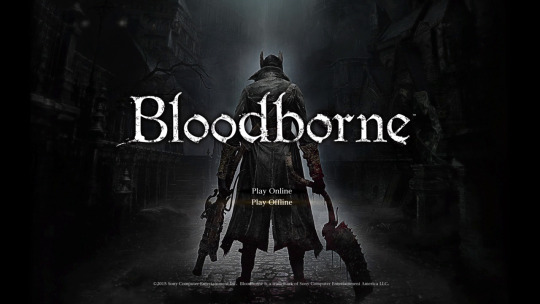
Let’s face it, video games can’t always be everything we want them to be. Whether because our expectations were just unreasonably high or because developers have finite time and funds with which to develop their creations, not everything gets to be fully explored. A standout example is Alfred’s subplot that bubbles under the surface of From Software’s Bloodborne.
For a game that’s already rife with intentionally incomplete information, making the player work to discover anything about the numerous secrets that envelop Yharnam, the storyline involving the Vilebloods is both an incredible entirely optional section and disappointingly underdeveloped. You learn of the Vilebloods from arguably the only actively helpful NPC in the game, Alfred. He can be found in a secluded alcove near the entrance to Old Yharnam, kneeling in front of a statue. If you talk to him, his chipper attitude and eagerness to cooperate can actually seem quite off-putting, considering almost everyone else in town has locked themselves up in their homes and distrusts everyone around them.

In your first conversation with Alfred, he divulges some information on the Healing Church and the College at Byrgenworth, giving the player some direction if they aren’t exactly sure where they should be going. Once Vicar Amelia is defeated and the password to the Forbidden Woods is learned, the player comes across Alfred again waiting just before the wood’s entrance. Talking to him again reveals a new line of questioning regarding the Vilebloods.
It turns out that Alfred is no regular hunter. He has devoted himself to following the path of the Executioner Logarius. The Executioners were a group of hunters bent on destroying the Vilebloods. Alfred voices his disdain for this group, though curiously, he doesn’t elaborate much on what makes them so hated. His worst criticism of them comes in the form of calling invitations to their parties “amusingly pompous”, which makes him sound a bit envious, really. He does reveal that the Vilebloods were born when a scholar from Byrgenworth stole blood and took it to Cainhurst Castle, though the identity of this thief and what the Vilebloods actually are is left unexplained.

The reason for this is that Alfred has no direct connection to the Vilebloods or the Executioners. He constantly expresses his admiration for Master Logarius, as he calls him, but the more you learn about the circumstances around the scourge of the beast, the longer the timeline of the events becomes. Given the lack of current action by any organized groups, there is little chance that Alfred could have come into contact with any living Executioners.
Where his devotion to the cause comes from is anyone’s guess, but it does explain his fanaticism a little bit. It’s easy to romanticize and idolize figures that you only learn about second hand, and twist events of the past to fit whatever worldview you hold. In many ways, Alfred is the most terrifying character in all of Bloodborne. His devotion to a master he never served and a group he never knew, and his hatred for the Vilebloods, whom he never encountered before the player opened the door for him, really makes you question his motivations. Once the player defeats Logarius and reveals the Vileblood queen’s chamber, Alfred goes in and pummels the Queen to a pulp. The player comes across this in the aftermath of the attack. Alfred declares his victory, utterly manic.
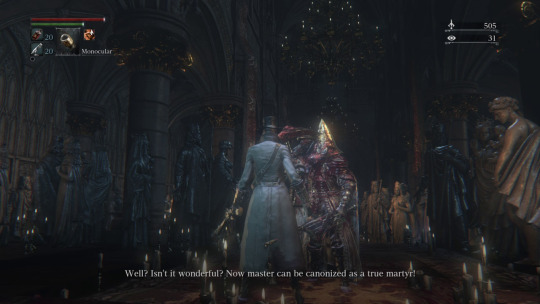
The result of Alfred’s bloodlust.
Of all the moments in the game, this was the most glaringly terrifying to me. Alfred’s capacity for vengeance and the pleasure he takes in completing his duty really gave me pause. He was as much a beast as anyone else, dressed in sheep’s clothing, perhaps. While he never turns his aggression out on the player so long as they don’t attack him, any camaraderie shared evaporates. More disturbing is that once his task is complete, Alfred returns to Logarius’ statue and kills himself in a sort of ritual sacrifice. With his life’s work now done, he sees no reason to continue living.
It’s amazing that Alfred and the entirety of Cainhurst Castle are completely optional. Perhaps because it’s so easy to miss this chunk of the game that From Software didn’t really want to risk tying it too closely to the rest of Yharnam. It’s not explicitly stated but through talking with the Queen of the Vilebloods, Annalise, you learn that the Vilebloods are vampires, of sorts. Somehow, the tainted blood that they consumed made them immortal. Annalise cannot be killed no matter how much Alfred smashes her, and her corporeal form can even be restored with the help of the player.
More importantly, the player can become a Vileblood themselves should they choose to partake of Queen Annalise’s blood. Unfortunately, swearing your oath to the Queen does very little to change the course of the overall game aside from the player joining the Vileblood’s covenant. You don’t gain any powerful items or abilities. You especially don’t get to behave like a vampire, and it’s sort of easy to see why. The player is already immortal and already injects themselves with blood to restore their health. The restorative effects when retaliating immediately after taking damage is also a bit vampire-like. Maybe it’s a bit of a stretch, but it seems that the return of health is due to the player being splashed with the blood of their enemies. It’s hard to shoehorn in literal bloodsucking when blood is already the focus of practically everything in the game. Still, it would have been interesting to add another way to acquire blood, perhaps adding a stealth element to the game where you could sneak up to unsuspecting victims and drain them of blood to restore health.

Ultimately, a meaningless gesture.
It’s a bit of a let down for joining the Vilebloods to result in no mechanical changes, but even worse is that there are no consequences, either. If you take the Queen’s blood and join the Vilebloods before you present Alfred with an unopened summons to Cainhurst, one would expect Alfred to turn on the player. After all, Alfred’s entire reason for existing is to destroy the Vilebloods. How is it he can stand the sight of you once you’ve become tainted?
On one hand, this seems like a pretty egregious oversight. Plenty of characters turn on the player or refuse to cooperate with them if they trigger certain events in the game. Eileen the Crow can focus her wrath on you should you manage to progress her story. Adella the Nun will come after you with a knife should you prefer Arianna’s blood to hers. Of course, attacking players almost always causes them to become hostile. Alfred follows this pattern as well, so it seems well within a reasonable possibility to trigger Alfred’s aggression upon becoming a Vileblood.
On the other hand, this is a brilliant piece of characterization. Alfred’s lack of response could very well just be a lack of recognition. The only Vileblood Alfred ever encounters, at least in a form he could make sense of, is Annalise. Since she identifies herself, Alfred would have only had to have talked to her for a brief moment before smashing her with his Logarius Wheel. Without such a clear indication, Alfred really doesn’t seem to have any way of identifying his prey so his failure to hunt the player down would make perfect sense. There are no obvious visual cues that would have tipped him off (though you do get a badge that theoretically he should recognize), your behavior doesn’t change, and you don’t have the capacity to vocalize your choice, so to him you look as you ever did, just a hunter on the hunt.
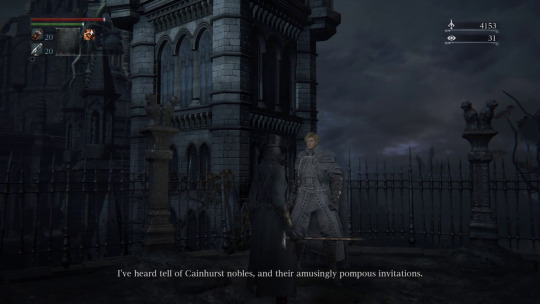
Alfred doesn’t even seem curious about how you got the invitation.
Alfred’s zealotry is all the more terrible because he executes it despite lacking any tangible reason to see it out. He knows what he wants to do and does it without questioning himself or anything else. This is exactly the opposite track that the player is intended to take. At the beginning of the game, Gherman tells the player not to think too hard about anything and to just “go out and kill a few beasts”. Of course, the more the player sees, the more questions they have and how they can’t help but investigate into them to find answers. Learning about Byrgenworth, discovering the secrets held there, uncovering the façade of the nightmare, and seeing the Great Ones that interfere with humanity, all of these things just lead to more questions. The more you learn, the more you realize you don’t know, to the point where you can’t be sure you really know anything.
Alfred is the counterpoint to the player, someone whose actions are confident and unwavering, who never really gets close to learning the real truth, that his fight against the Vilebloods is completely inconsequential in the grand scheme of things. For all the work he goes through, he doesn’t achieve anything. Annalise already had no influence on the world, locked away by Logarius. Mashing her into paste didn’t make her less of a threat, yet he doesn’t care about that or even seem to realize his impotence. Given the state of the world, you, the player, are the only one alive who would recognize his accomplishments, anyway.

You are the only witness to any of this.
The player is supposed to slowly realize their own insignificance. Despite killing more and more powerful beings, there is always something bigger, something more terrifying to face. You don’t really know what you’re trying to accomplish, let alone whether or not what you’re doing will have the intended results, so in that sense, Alfred is still one of the most compelling characters, despite there seeming to be significant amounts of his story left out of the final game.
Honestly, I don’t really know which version of the game I would have liked more. It would have been wonderful to explore some more mechanics and really give weight to the change from Moon Scented Hunter to Vileblood. From Software games are so interesting because they put so much significance on the choices you make while playing. Kill an NPC and you might lose access to something you could have used or created a new enemy elsewhere. The opportunities to expand on the vampire myths we all love and with a little bit of the Miyazaki touch is an idea as intoxicating as the blood of Yharnam itself.
144 notes
·
View notes
Text
Oregon Trail II: The Sequel that Nobody Asked For

Of all the games that did not need a sequel, The Oregon Trail has got to be darned near the top of the list. While the trail blazing (pun intended) edutainment blockbuster conflates numerous journeys across various routes spanning decades of the 19th century, it’s safe to say that for a humble 1980s computer game, it did an incredible job of letting kids know what the pioneering experience was all about.

Spoiler alert! It was mostly about malnourishment and dysentery.
For those unfamiliar, The Oregon Trail was produced by the Minnesota Educational Computing Consortium, known by schoolchildren everywhere as MECC. The game was released for numerous platforms, including the Apple II, DOS computers, and the Atari 8-Bit platforms. Its popularity cannot be overstated. Such popularity led to releases to newer platforms, prompting updates to extend the game’s longevity. The Apple II version eventually gave way to the Macintosh version, the DOS version likewise was retired in favor of Windows.
Updating an educational piece of software like The Oregon Trail seems like the perfect strategy for perpetual sales. The historical framework that the game is centered on doesn’t change, but could easily be adapted into more modern forms of video game storytelling, allowing kids to get a better and better representation of what the endeavor might have been like. Simply updating the game and re-releasing it would seem like a practical inevitability, just as the math in textbooks doesn’t change, but new editions keep being made anyway to feed the publishing industry monster, whose thirst for paper is insatiable.
MECC did keep up releasing Oregon Trail for as long as it could. Interestingly, though, somewhere along the line, they got the idea in their head that putting a new paint job on the game and slapping that classic logo on the box just wasn’t quite enough to keep interest up. No, fueled by the lust for the dollars that sequels bring, MECC decided they were going to make Oregon Trail II. I know what you’re thinking: “How on earth could MECC top their greatest creation?” Or maybe you’re more realistically thinking “How can you create a sequel to a historical event?” Let me tell you how.
Oregon Trail II: The Oregoning (if only) is the exact same game as its predecessor in just about every meaningful way. What exactly was the difference, then? Why, oh why did this thing need to be brought into the world? The CD-ROM, of course. CD-ROM technology ushered in a revolution of adoption for computers. For a multitude of reasons I don’t have the time nor expertise to suss out here, CD-ROMs fundamentally altered how the public thought about computers and their utility. At the heart of it seems to be that the data storage capacity of these optical discs meant computers could render more convincing and realistic worlds to the masses, making computers less mysterious and threatening, and much more inviting, like a VCR.
CD-ROMs meant that encyclopedic knowledge could suddenly be stored and accessed not in heavy and annoying to thumb through books, but rather on light and easily searchable programs loaded from the disc. Looking back, this all seems a bit quaint, but it was very exciting for the time. This was before the internet had become such a staple of modern life, so having easy access to lots of data via compact disc was very attractive and opened a lot of possibilities. These possibilities were especially attractive to game makers. Remember, it was the compact disc that caused Squaresoft to jump ship from Nintendo to Sony, giving us Final Fantasy VII. To date, there has not been a superior invention. In any case, MECC, like Squaresoft (only two years before Squaresoft), saw the potential of CDs to really give their tried and true Oregon Trail a kick in the pants.
While the hype was literally unreal for this sequel, we do have to be real about it. Oregon Trail II is almost exactly like The Oregon Trail. Nearly every change is superficial in nature, but those superficial changes apply to essentially every aspect of the game’s presentation. The first thing players will notice is that Oregon Trail II has a full musical score, and, depending on your taste, that score kicks ass. Music of this quantity and quality was simply not possible on this scale before CD-ROMs had become the main platform for computer games. Along with the music, the game features numerous voice samples, which add a nice element to the various characters that the player can interact with over the course of their journey. While text works just fine, let’s face it, having the words spoken to you makes it both easier and faster to understand. While I wouldn’t say the actors are stellar, for an educational game, they are perfectly adequate, on par with what you’d get visiting a historical re-enactment of some kind.
Graphically, the game received a huge upgrade as well. Digitized actors were placed in the game, making the re-enactment comparison that much stronger. In the beginning of the game you can explore the town adventure game style with each location being a single scene populated with various NPCs. While hopelessly dated by modern standard, it would be difficult to say that in 1995, this didn’t seriously enhance the immersion that the game was going for. What was just a simple screen where you input numerical values for the supplies you wanted became a place you could explore, which is always nice.
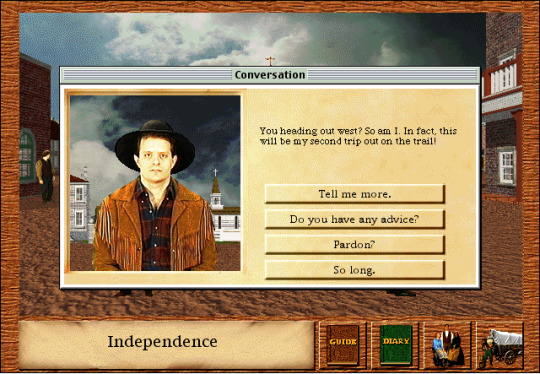
This actor’s face says “No amount of money is worth this.”
The player is faced with multiple choices they must make in order to make their trip to the West successful. Lots of unexpected events will take place, such as oxen dying, yokes breaking, people getting ill or lost. Whenever hardship falls upon your party, you must make a decision regarding how you will proceed, and your choices affect what happens next. You’re not alone, however, as the people you travel with can be consulted, adding an extra dimension to the experience.
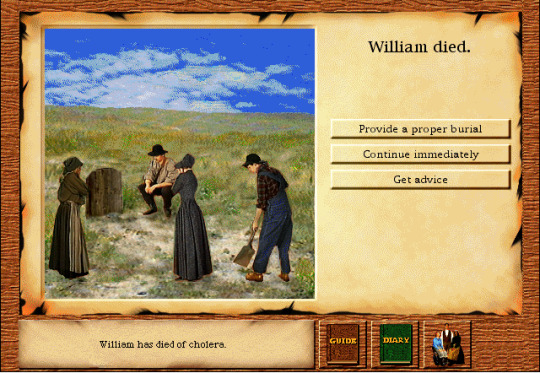
Not sure how we could continue immediately when we’ve already buried him.
The most useful update came in the form of the map that would fill the screen as the player made their way across the trail. It is a highly detailed map, which gives both an incredibly accurate reading of where you are at any given time, but also helps set in the scale of this journey. In the Apple II days, it was admittedly a bit difficult to get a sense of just how grueling this journey must have been. Sure, all your party members were likely to die horrible deaths along the way, but that occurred around a nice animation of oxen walking. Oregon Trail II feels much more traditionally educational with it’s map tracking, but seeing the topography of the area and watching as you make your way from one side of the map to the other, only to have it adjust to a whole new section of map hammers home the fact that this trip was insane.
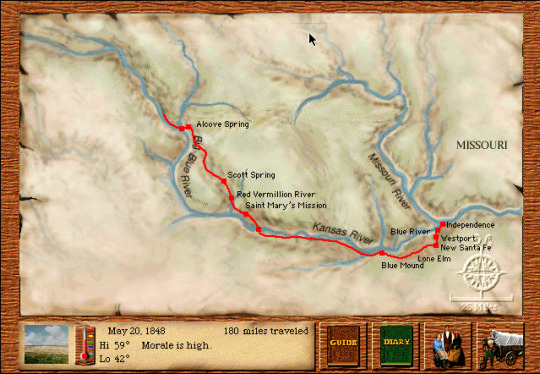
Ultimately, the wow factor of CD-ROM technology did not make Oregon Trail II the runaway success that The Oregon Trail had been. I’m pretty sure the only reason I played it back in 1995 was because my parents taught elementary school, and thus my home was full of all kinds of education software. On a personal level, I absolutely loved this game, even more so than the original. I’m aware, however, that it had no real chance of supplanting the classic that defined edutainment for so long. Something as iconic as The Oregon Trail is a rarity in any medium or industry, and it would be foolish to think that repackaging something and calling it a sequel could have the same impact. Whether or not the good people at MECC thought it would, I have no idea, but I’m glad they went ahead and made it, anyway, if for nothing else then to hear the Trail theme go from upbeat to more and more frantic and ominous as my party inches closer and closer to California, and cholera, and measles.
6 notes
·
View notes
Audio
Gabe and I dive into our favorite games from 2017. Instead of going through and saying a bit about each of the games we enjoyed, we decided instead to spend more time on one game each. Picking a favorite is always hard, and maybe our opinions will change over time, but for now, this is what we’ve come up with. Hope you enjoy it.
0 notes
Text
Good Health: Managing Risk Versus Reward in Shadow Tower
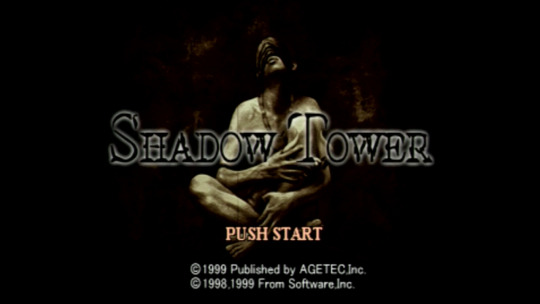
From Software has a long history of finding a formula that works, then introducing small refinements to that formula over time in order to make the games that are concocted with these formulas more appealing to new players. When it comes to their fantasy RPG games, From is remarkably consistent with regard to design philosophies, even as they find creative new ways to repackage the core ideas that got them started as a video game developer. Most of the tropes lauded to no end in the Souls games have their roots in From Software’s very first game, King’s Field. The methods of environmental and item description storytelling, the bleak and sorrowful tone of the settings and characters, the feeling that the odds truly are impossible; it’s what makes From Software games From Software games.
The adherence to the formula that has earned them the reputation they enjoy has had few revolutionary innovations. Demon’s Souls introduced Soul form for your character, where your health is halved when killed in Human form. It also introduced the beloved online system of semi-anonymous player phantoms that can be summoned to aid you on your journey or can invade your world in order to kill you dead. Dark Souls introduced Estus, a method of healing that had a finite number of uses between bonfires (checkpoints) to the traditional stockpiling of healing items. Bloodborne had Insight, a mechanic in the form of an item that when collected, made subtle changes to the world and revealed more of that world to the players that had previously been hidden. It was a way to gamify the growing madness the player character would be undergoing through the acquisition of more and more of the eldritch truth about Yharnam and the universe.
Shadow Tower’s great contribution to the action RPG landscape its gamification of player health. Health, measured as HP, is at the center of combat and the game’s internal economy. Understanding the systems that govern it is vital to navigating the game world. It must be tightly controlled in order to survive and carefully manipulated in order for the player to acquire and maintain the tools they will need to undergo the harrowing trials they will face. Decisions about it must be made constantly, with the potential benefits always being weighed against the possibility that death may be found swiftly and unexpectedly.
To talk about how HP is used as a currency, first we have to talk about how it’s replenished, since so much of it will be lost during the course of play. Thankfully, Shadow Tower is pretty forgiving on this front. To regain lost health, must consume a Healing Potion. These potions can be found in various locations throughout the world, can be dropped by certain enemies when slain, can be bought from vendors using Cunes, the standard in game currency, or can be traded for with weapons.
This trading aspect forces players to balance multiple types of currency in order to optimize the outcomes as much as possible. Unlike gold in the King’s Field games, Cunes are very limited and can only be acquired by exploring the Shadow Tower’s worlds. There are a fixed number, thus putting a hard limit on the things you can buy with them. Trading Cunes for Healing Potions is the most obvious way to ensure you make it through enemy encounters since they cost a single Cune each, but what you need at any given moment depends greatly on what you’ve managed to procure through exploration and combat. Maybe you’ve stumbled across a lot of Healing Potions but very few weapons or armor pieces. Suddenly that shield isn’t looking like such a bad purchase, even if it does take very last Cune you’ve found.
To complement the Cune economy, the tower is populated with various smiths that trade in potions. Some will give you a Healing or Magic Potion in return for a piece of equipment. What makes this option so compelling is that it seems like a bit of a raw deal early on. All the equipment you have was likely picked up from killed enemies or just found while walking along since buying equipment with Cunes is so expensive. Having a lot of equipment on hand is paramount to ensure you aren’t suddenly stuck with nothing but broken weapons and armor, which can’t be used. Trading even a weak short sword feels like asking too much. That extreme cost shifts over the course of the game to feel a lot more reasonable the later deeper into the tower you go. Over time you’ll accumulate a fair amount of gear, some of which will be duplicates of stuff you already have. You’ll be much more willing to part with your short sword once you’ve got three of them.
What’s really beautiful about all of this is that players will eventually stumble on another type of smith, one that repairs equipment in exchange for HP. The amount of HP it takes to repair an item varies depending on the quality of the item and how damaged it is. The more powerful the item, the more health it takes, as it is with the more worn down it is. Broken items can also be repaired, but doing so requires a great deal of health, more than you might have in total when completely healed. This instills in the player the mindset to never let equipment break, but still provides value to broken items since they can be traded for health, if the cost to repair them is too high or the item simply isn’t going to be used anymore. All of this makes it so there’s always a give and take with every transaction. In order to remain fighting fit, you have to sacrifice your HP, thus forcing you to use your Healing Potions, thus forcing you to spend Cunes or equipment to acquire more Healing Potions so you can heal up and repair equipment.
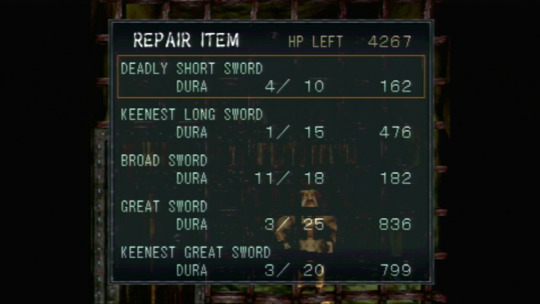
The health costs are actually pretty reasonable considering Health Potions fully restore your HP.
It’s an absolutely brilliant system, and one that means your first playthrough will be constantly fraught with tension. Not knowing what lies ahead in a new region of the game means not knowing what you’ll want on hand. Is it important that your weapons be in top shape because there are lots of enemies to hack through? Is it more important to make sure you have lots of potions to heal up as you make it past difficult to avoid traps? There’s also the question of not knowing how far it will be to the next smith or which smith you’ll find. From Software played a bit of a nasty trick in making only one smith symbol despite each smith only entertaining one kind of transaction. To find out what they are selling, you have to visit them. It can feel like a punch in the gut when you really want to offload some low grade gear for Healing Potions and all they’re offering is Magic Potions. Remembering which smith resides where becomes crucial component of level memorization as a result.
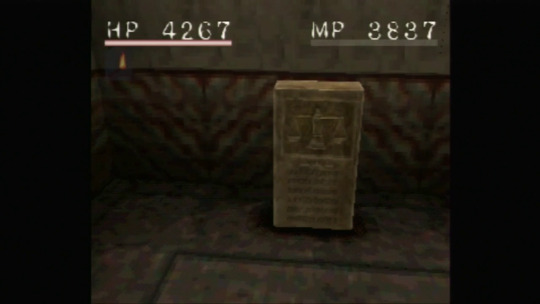
These tend to be more relieving to discover than save points.
In some ways, Shadow Tower represents the most sadistic side of From Software. There’s a lot riding on making good decisions all the time. This is especially true early when resources are more limited and the scope of the game hasn’t yet started to sink in. It can be overwhelming trying to figure out if spending a Cune now will end up paying off later or if you should wait to see if you get lucky and find what you’re looking for in the tower. It’s a lot to make players deal with right out of the gate. Poor item and health management can compound to make the game frustrating as the only way out of it is to explore more, exposing you to serious risk.
On the plus side, it’s not all balanced extraordinarily well. If you take risks and explore the beginning areas thoroughly, you can acquire a healthy amount of Cunes, equipment, and potions, allowing you to amass a bit of wealth. With more stuff to spend, the impact of each decision is lessened significantly. The game is also lenient in that most areas do not have re-spawning enemies. Once killed, they are dead for good, so backtracking to a known smith or Cune vendor to regroup is pretty safe and only really takes up a bit of the player’s time.
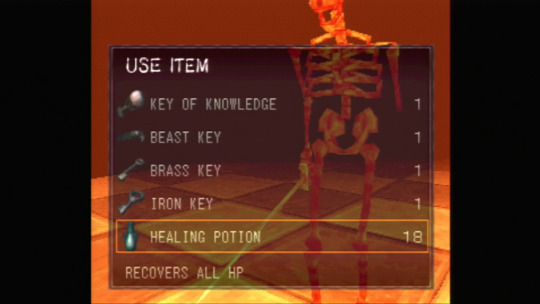
I can spare one of these to not die, right?
With just how deeply intertwined the economy mechanics are in Shadow Tower, and how impactful those mechanics are in creating a hostile yet interesting experience, I’m surprised From Software never returned to it after Shadow Tower’s sequel, Shadow Tower Abyss. Perhaps it was too off putting for most players. Maybe they felt they explored it as much as they could in the two games that used it. Or maybe there were simply other priorities when crafting the reboot of the company’s fantasy philosophies for the modern era that it just never made its way back into the mix. Whatever the case may be, Shadow Tower is still one of From Software’s most interesting,challenging, and rewarding games, thanks largely to their willingness to experiment. They bothered to ask “What would happen if we made health a currency?” and didn’t shy away from the results.
2 notes
·
View notes